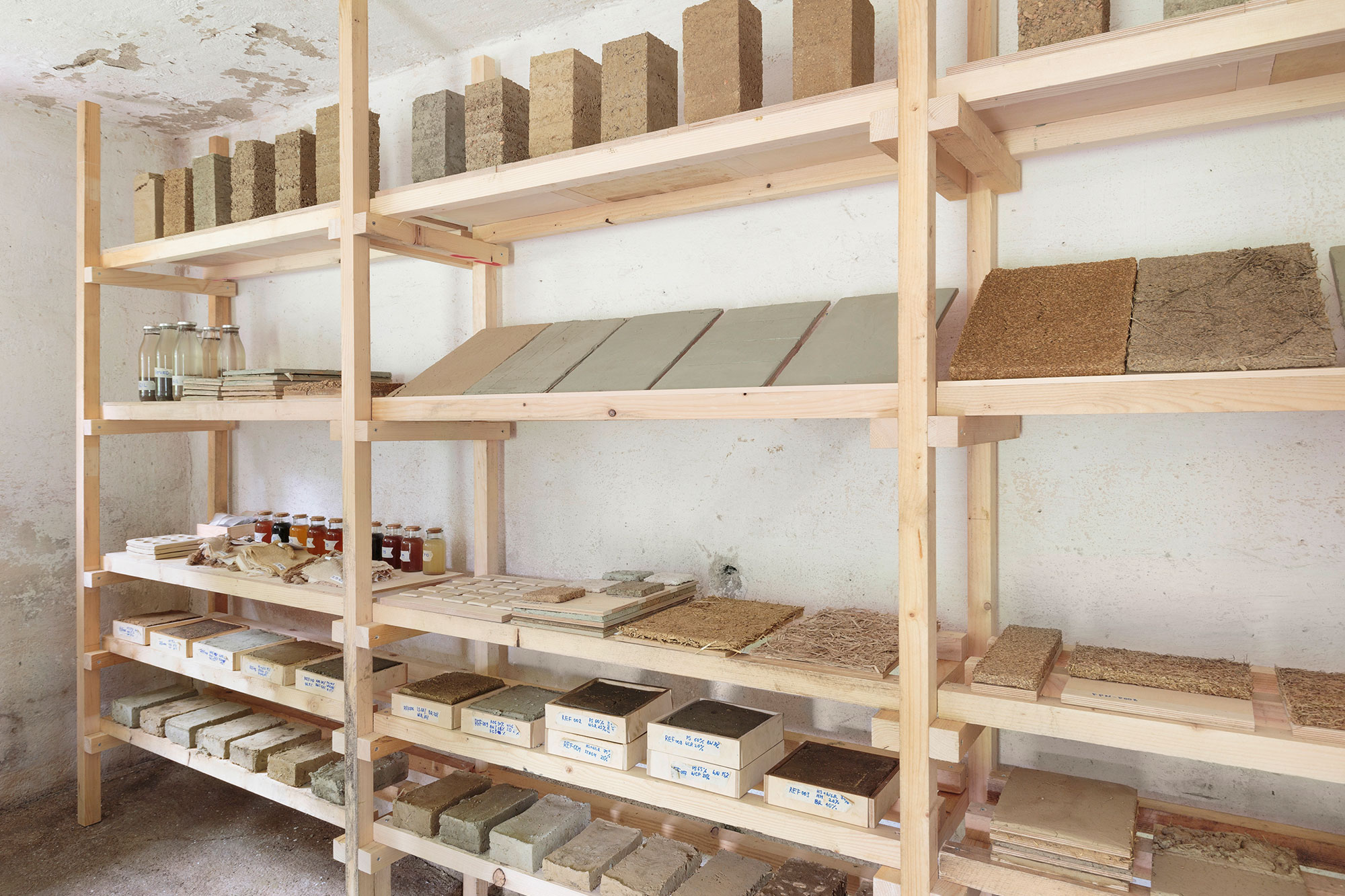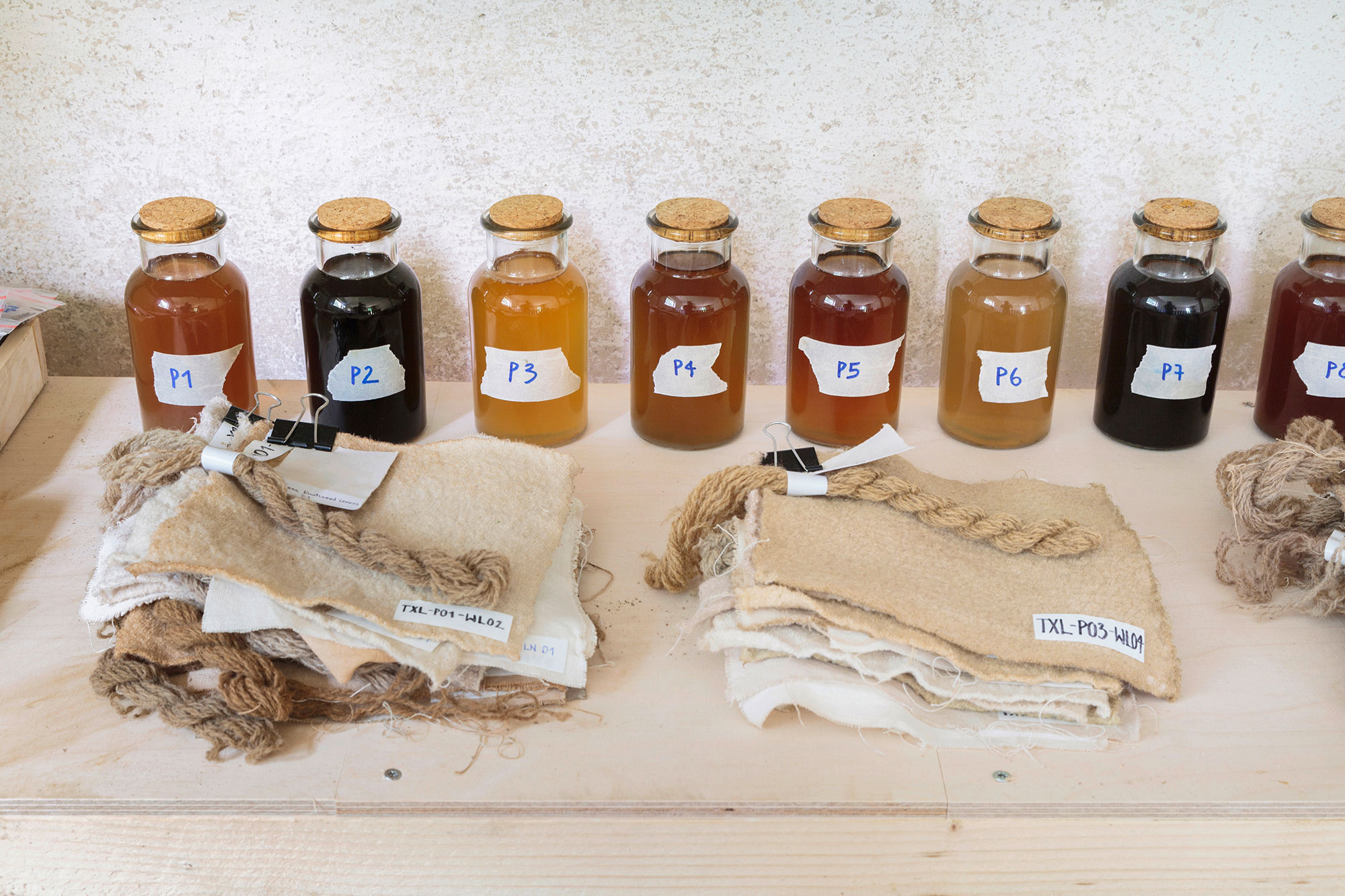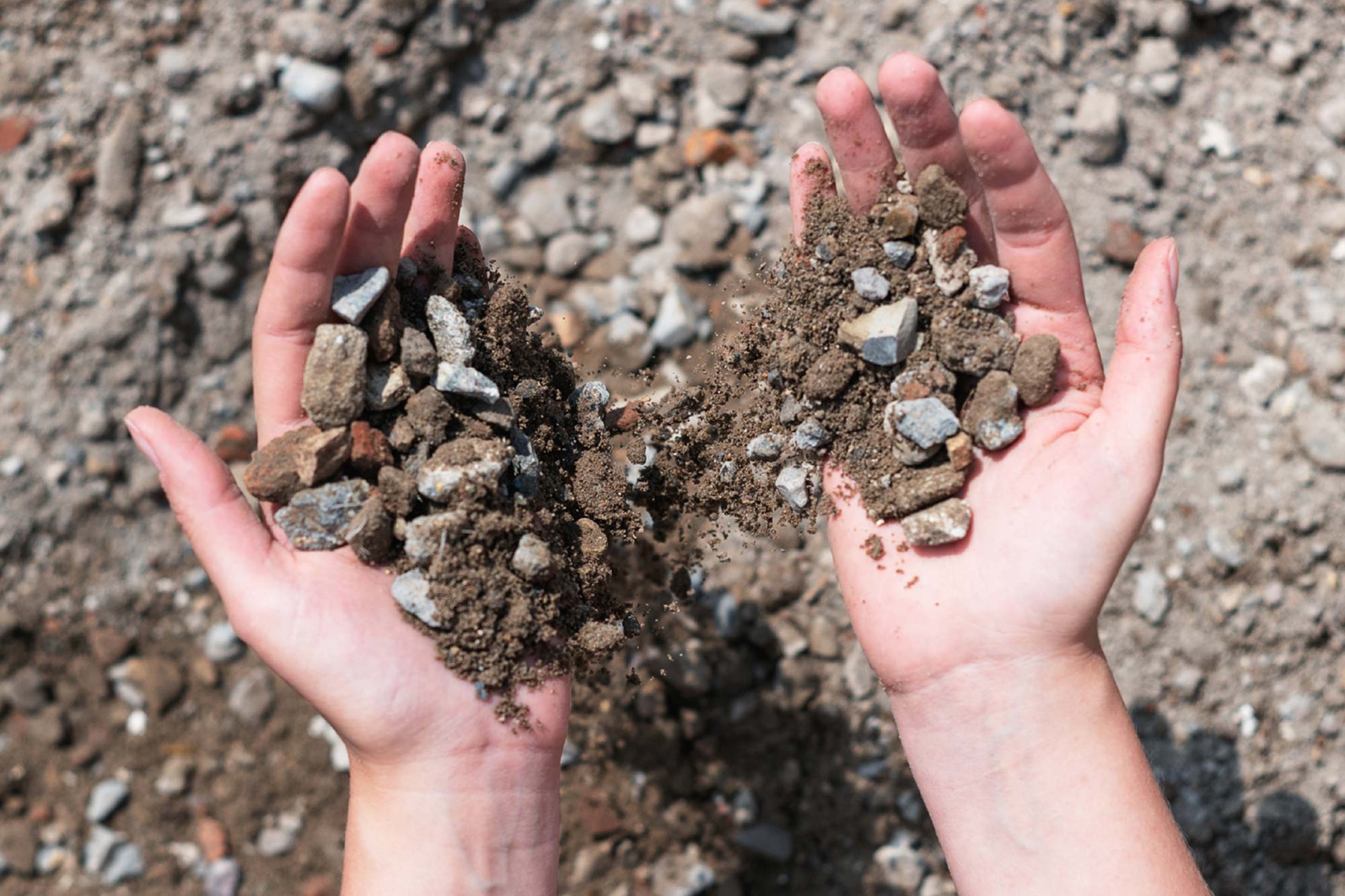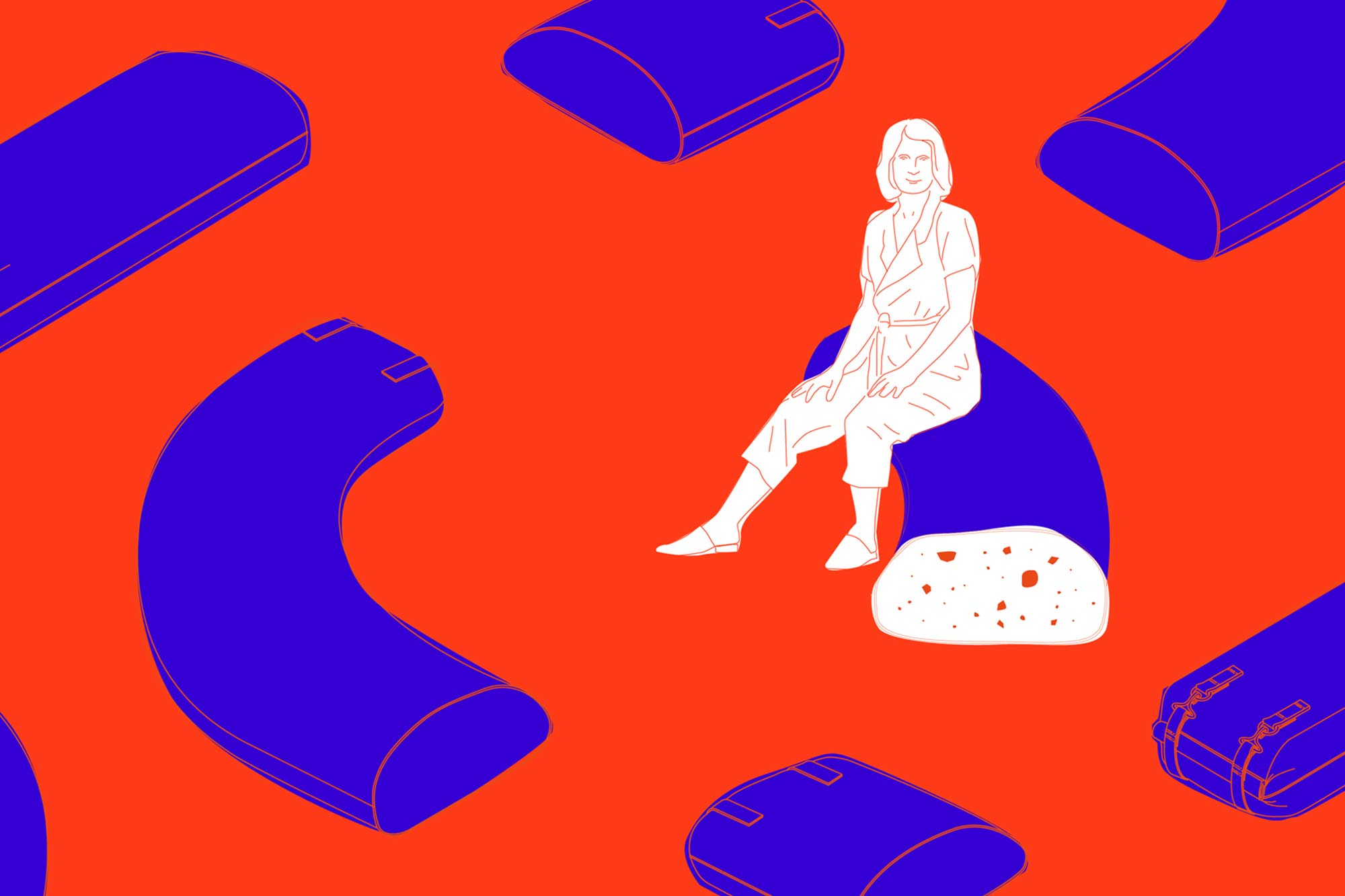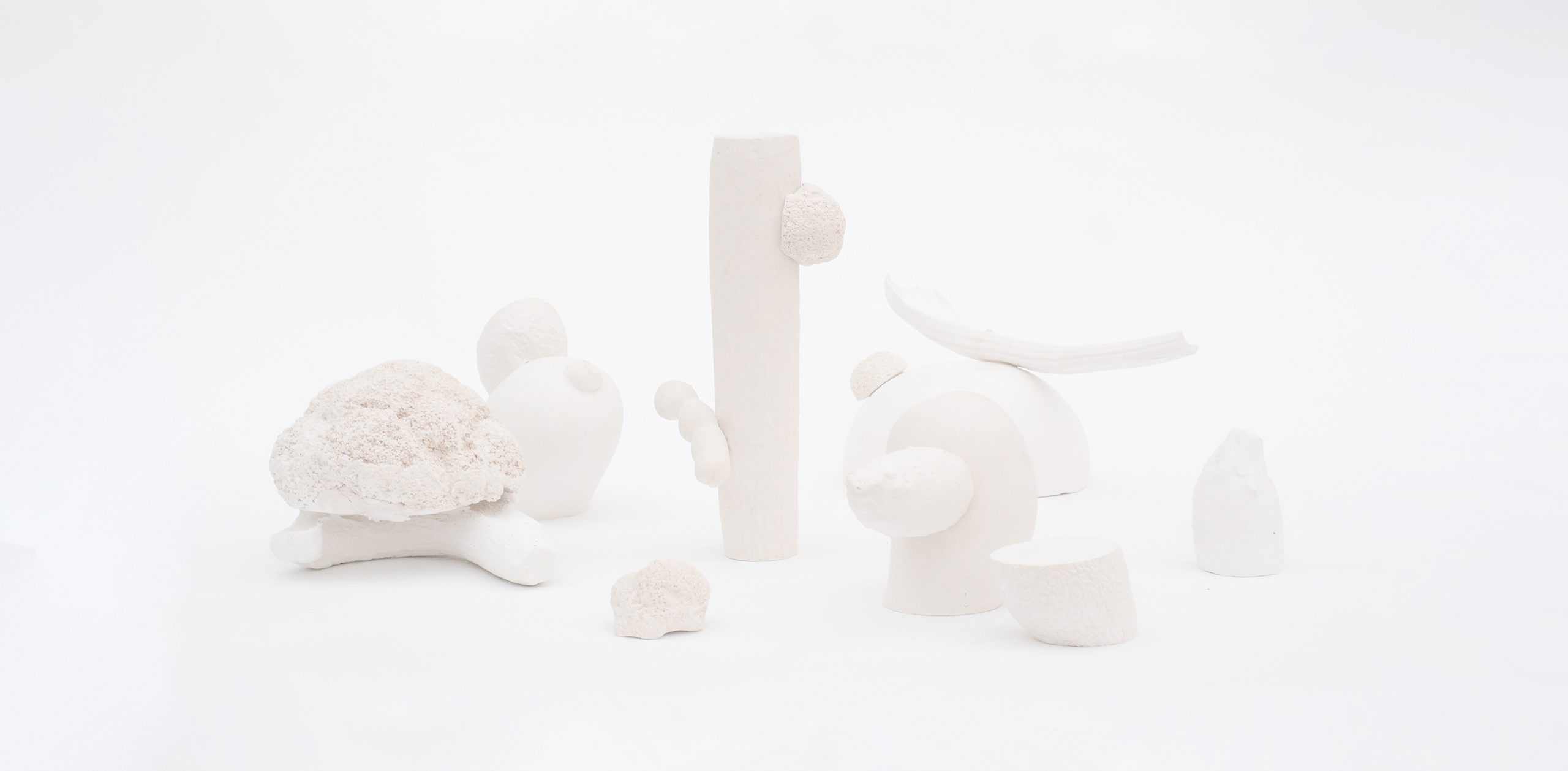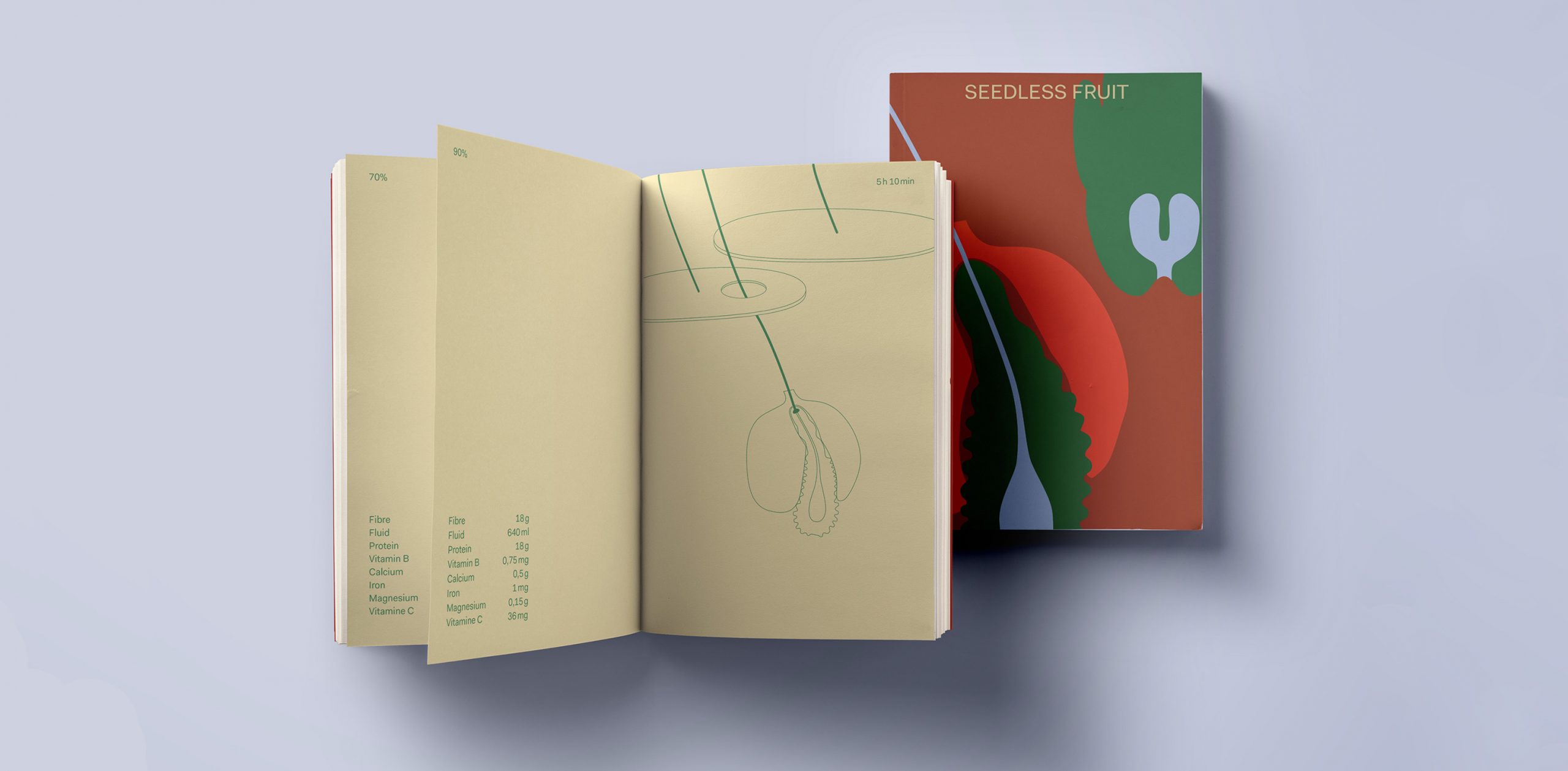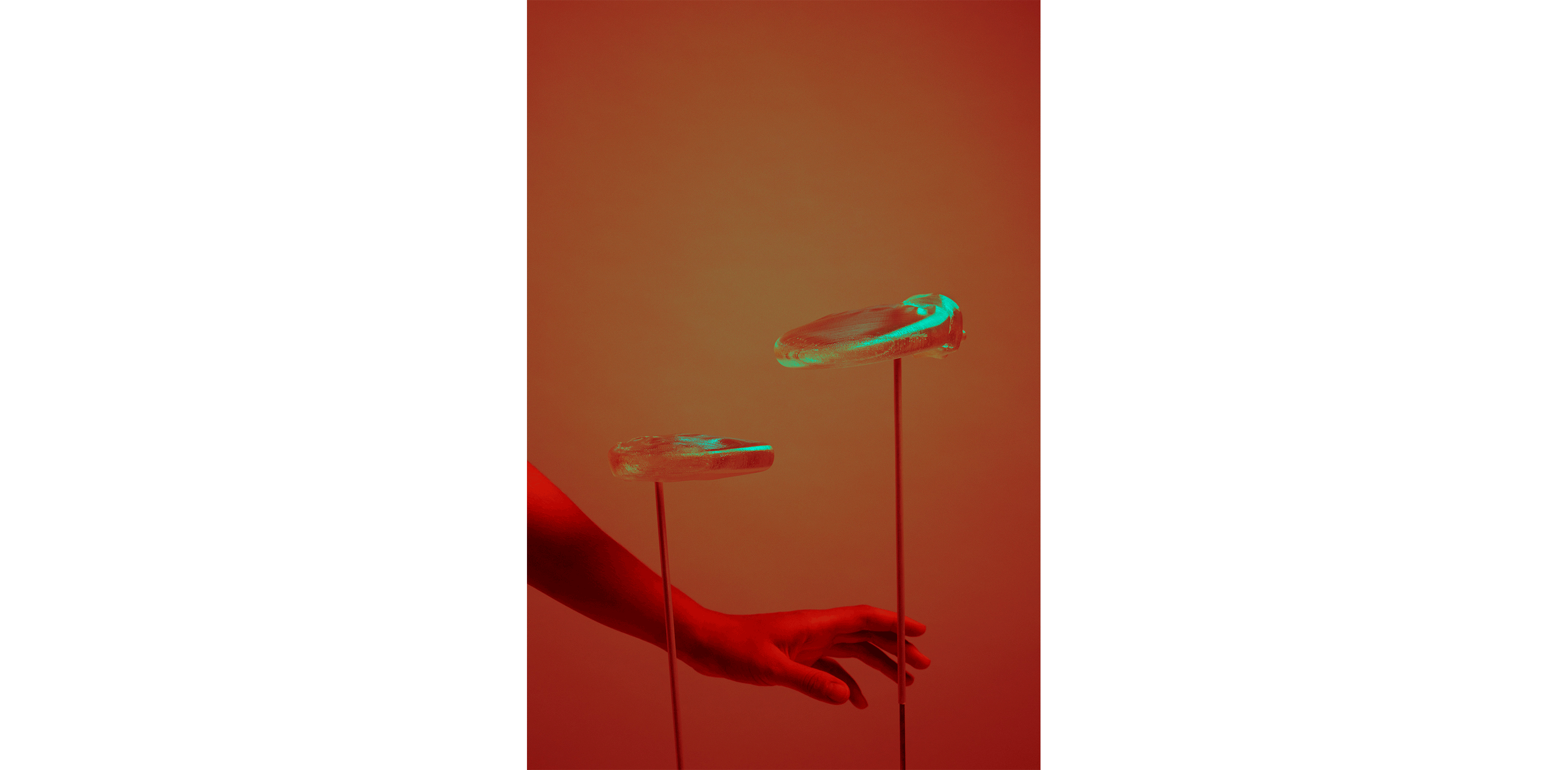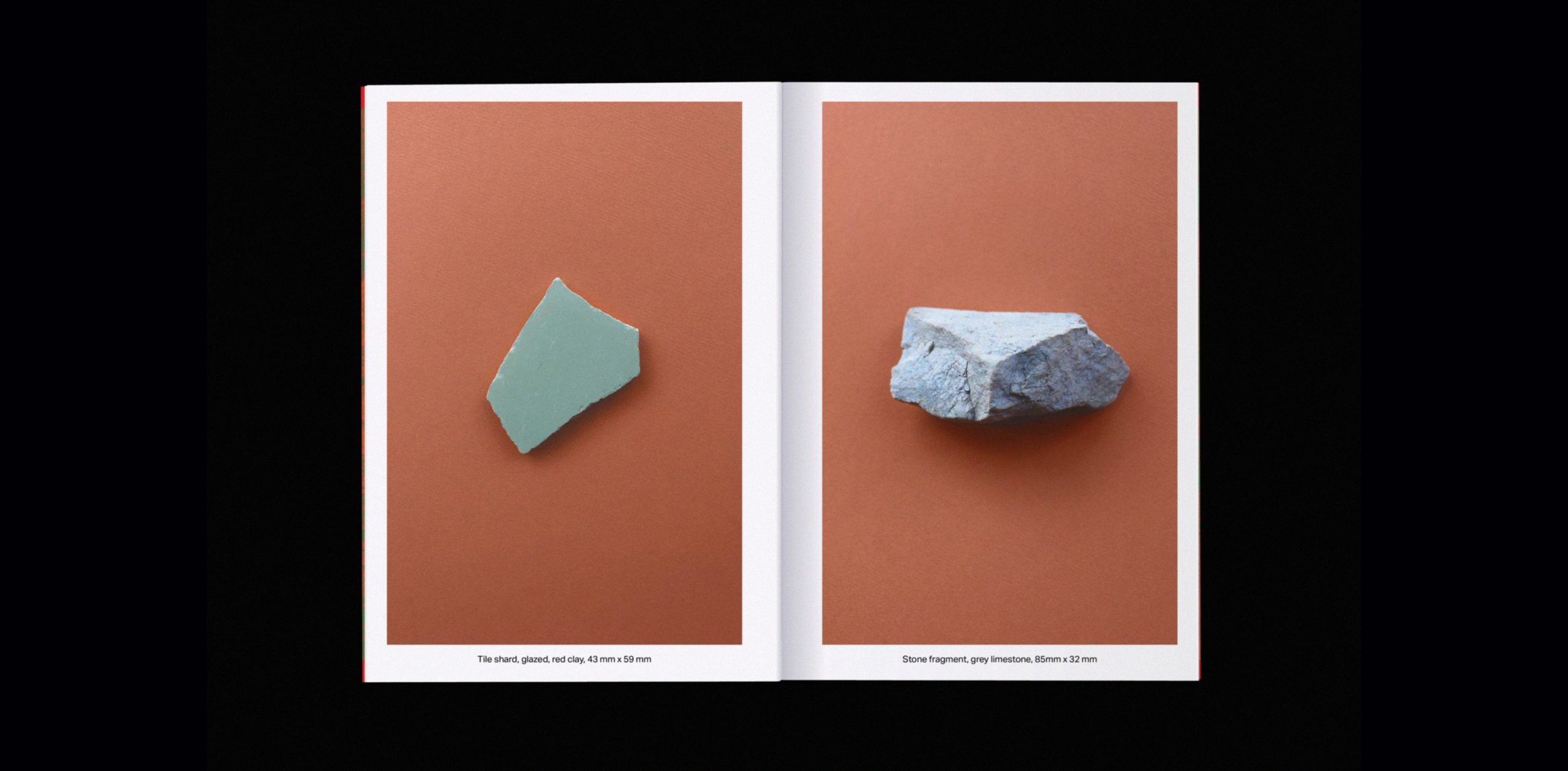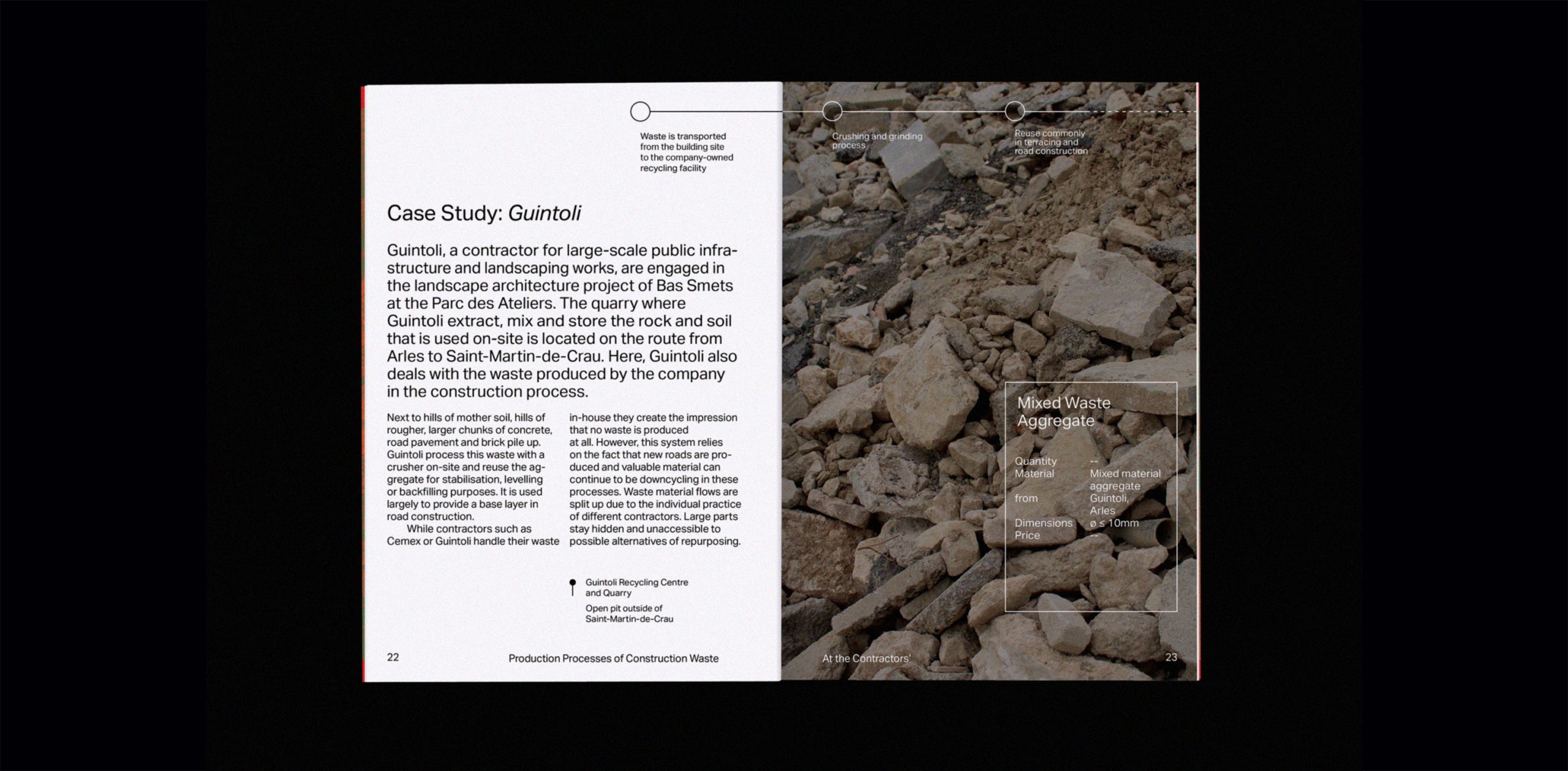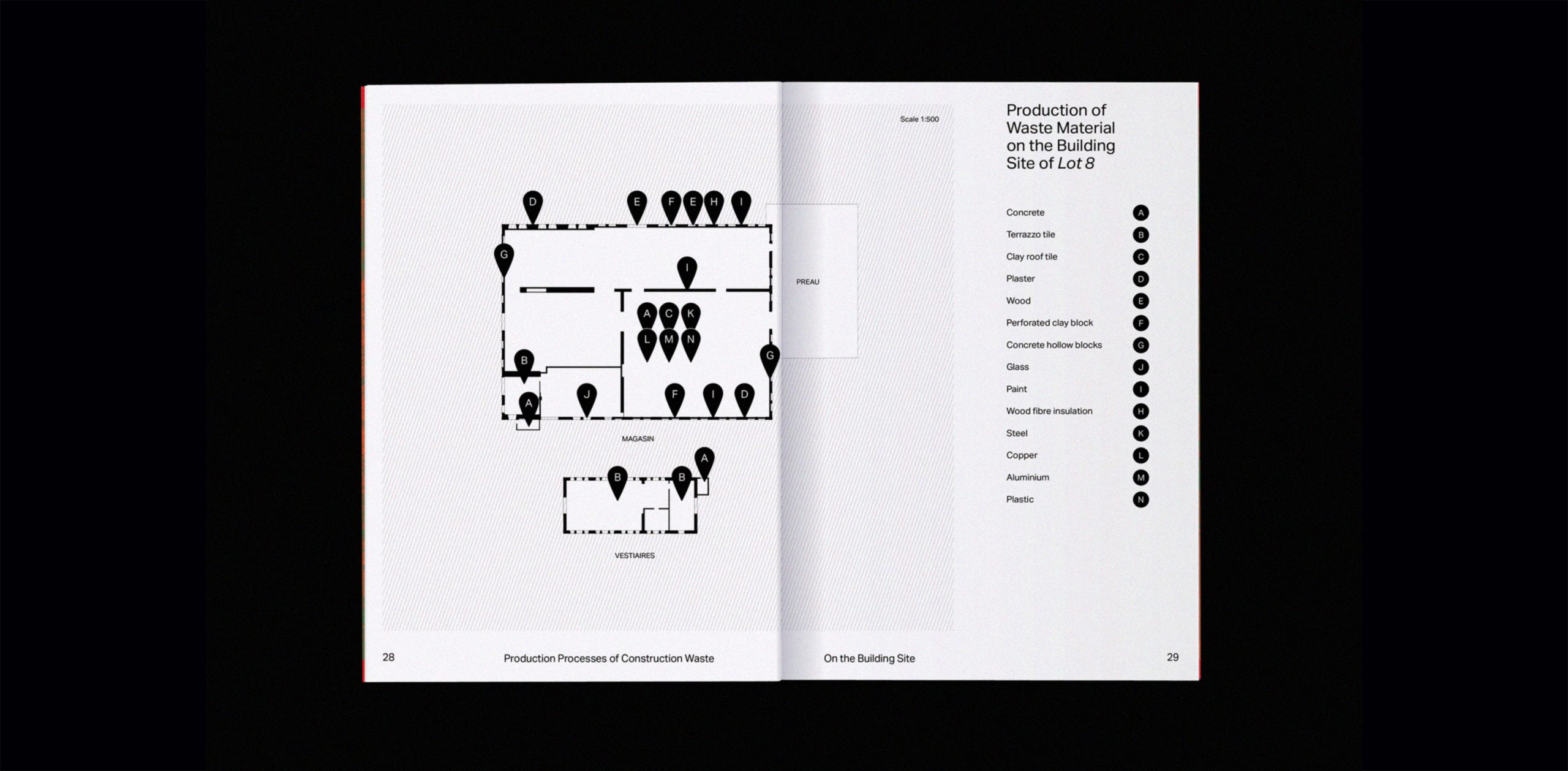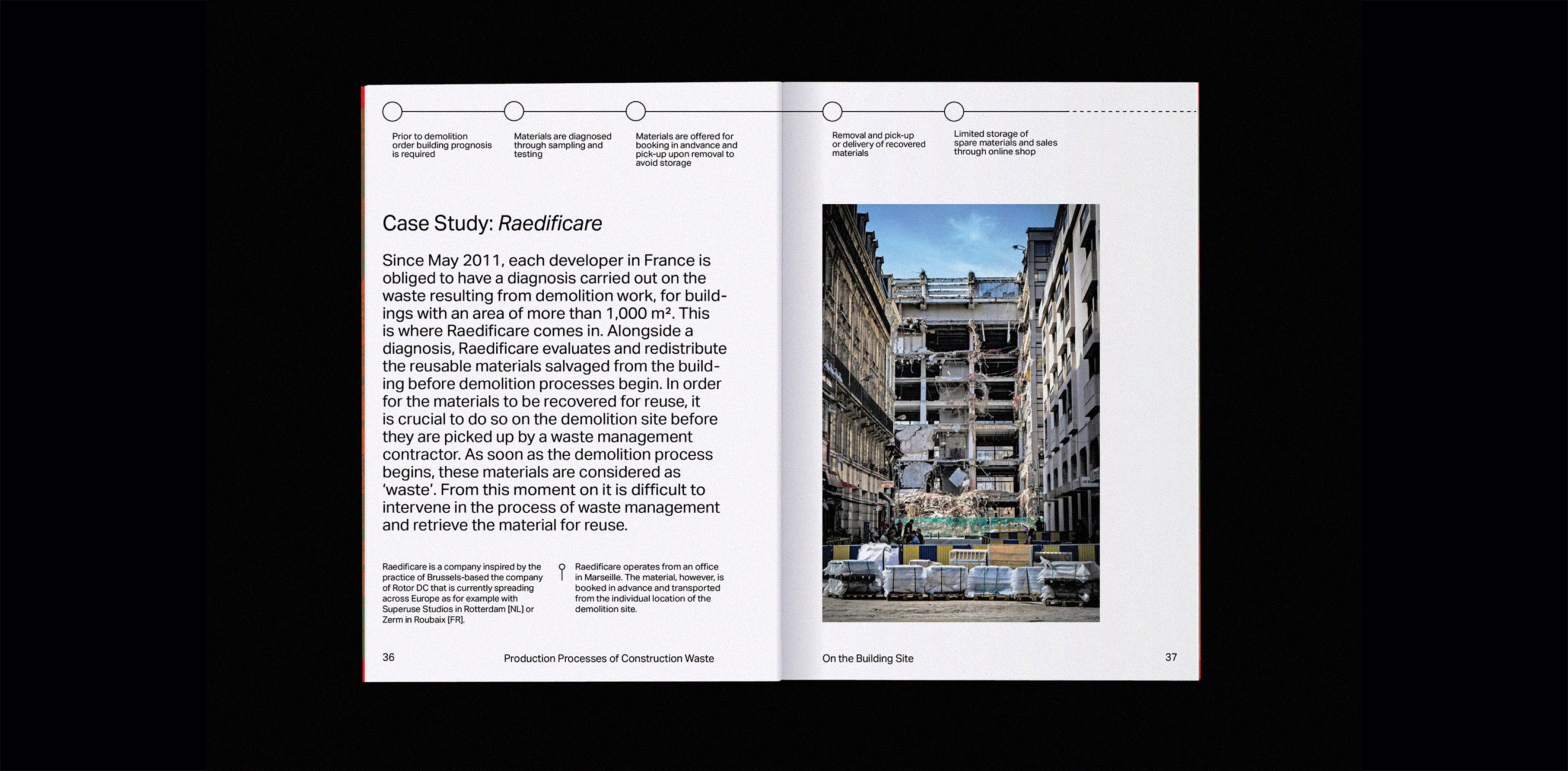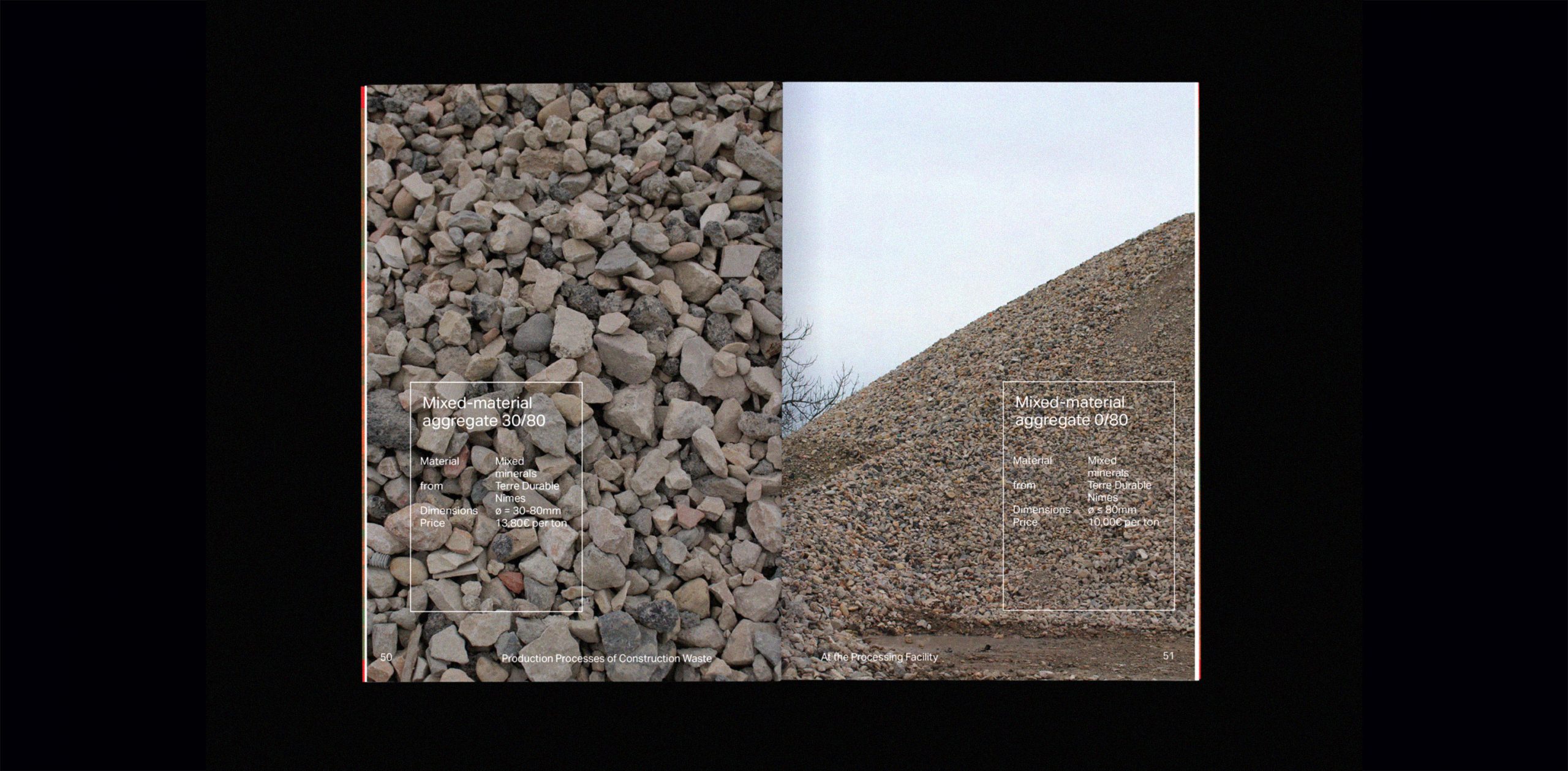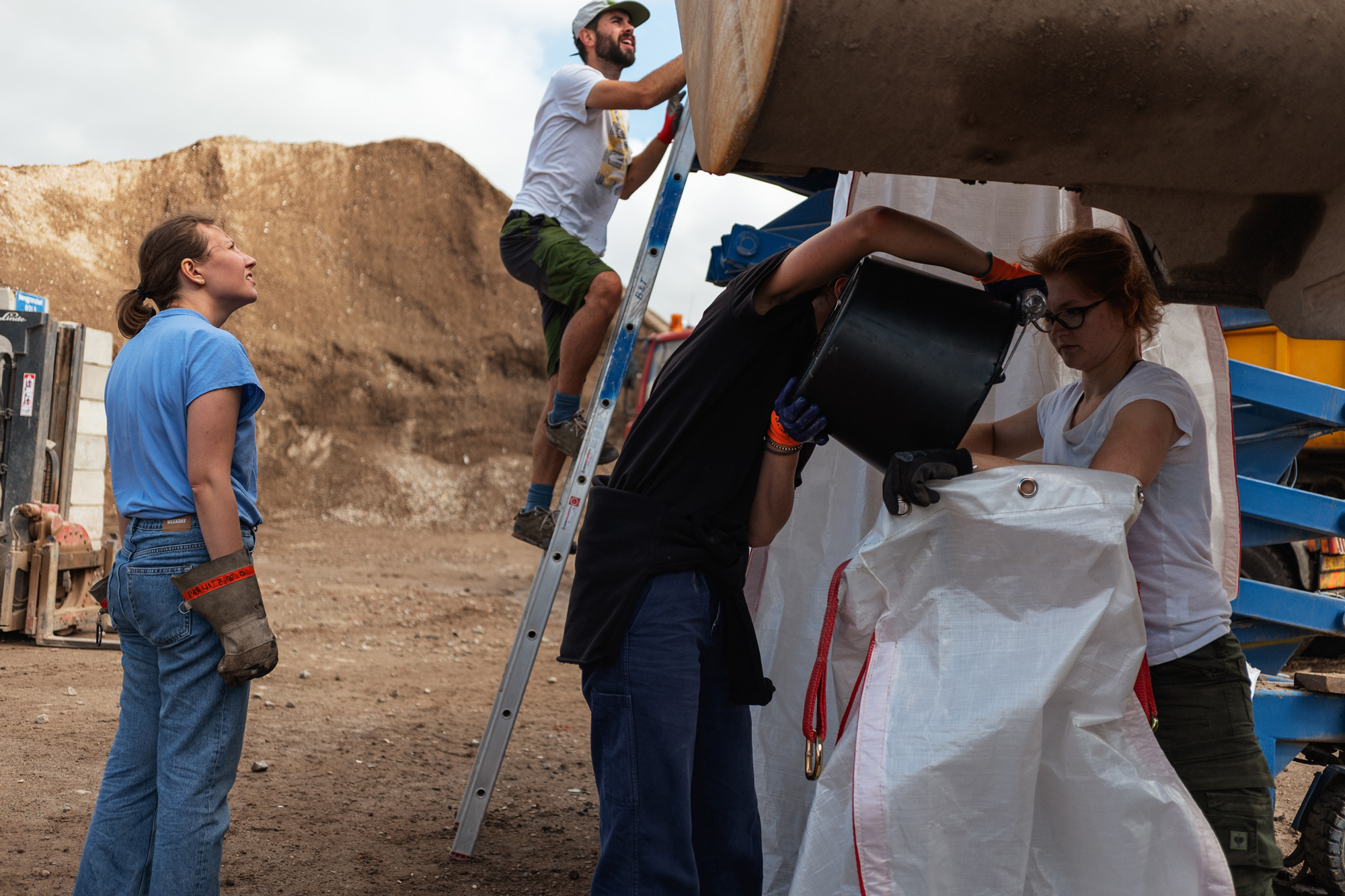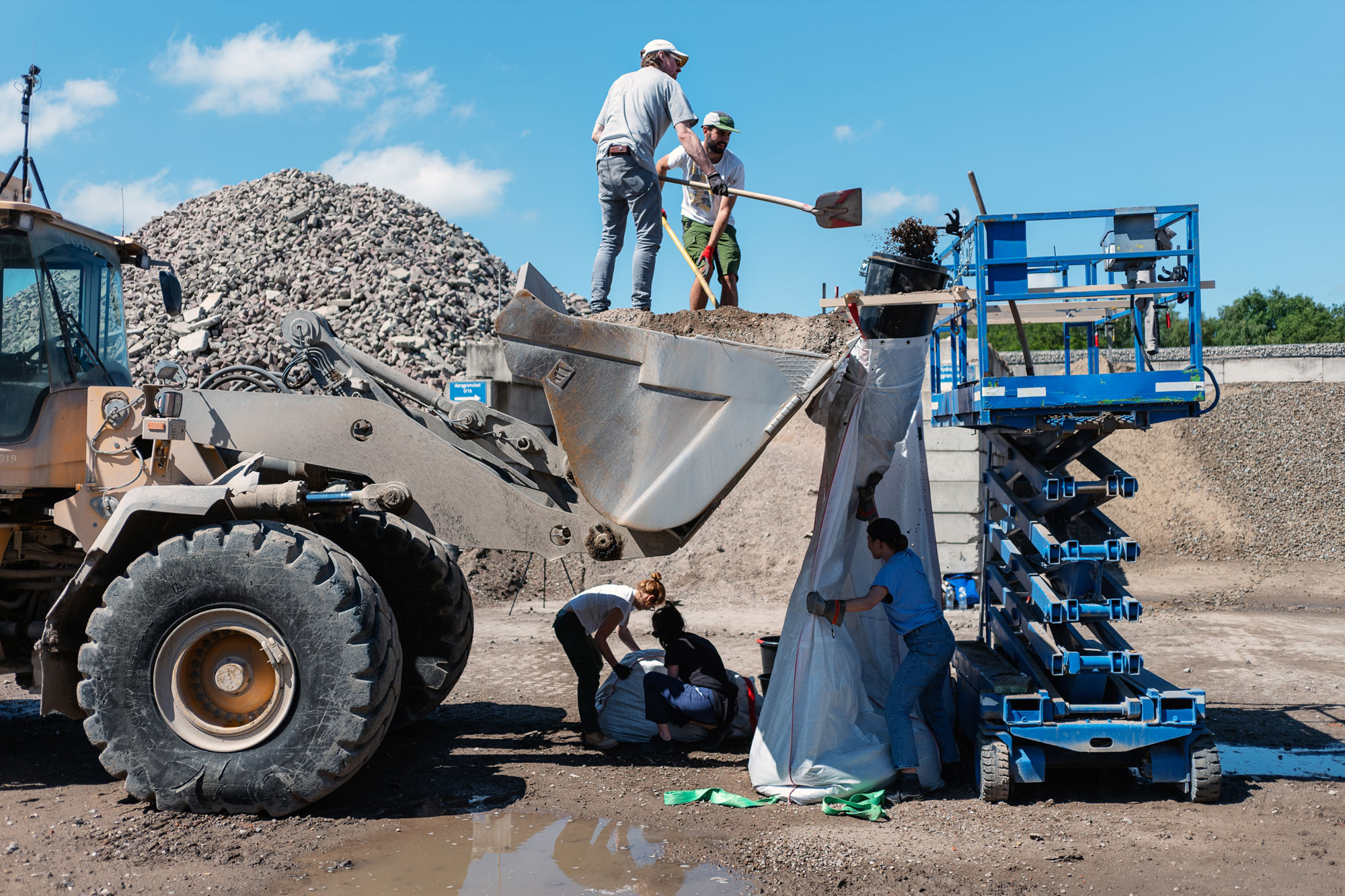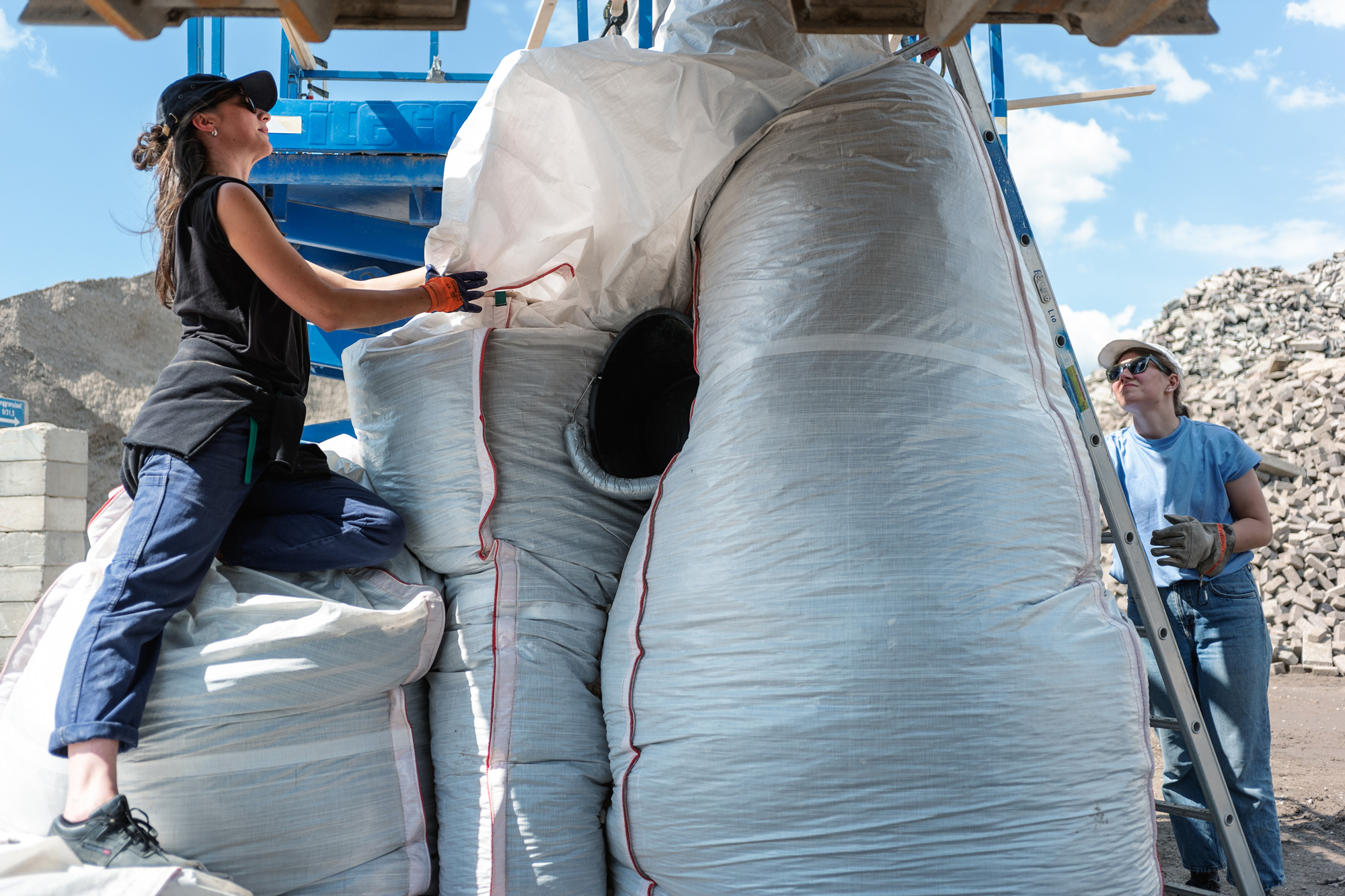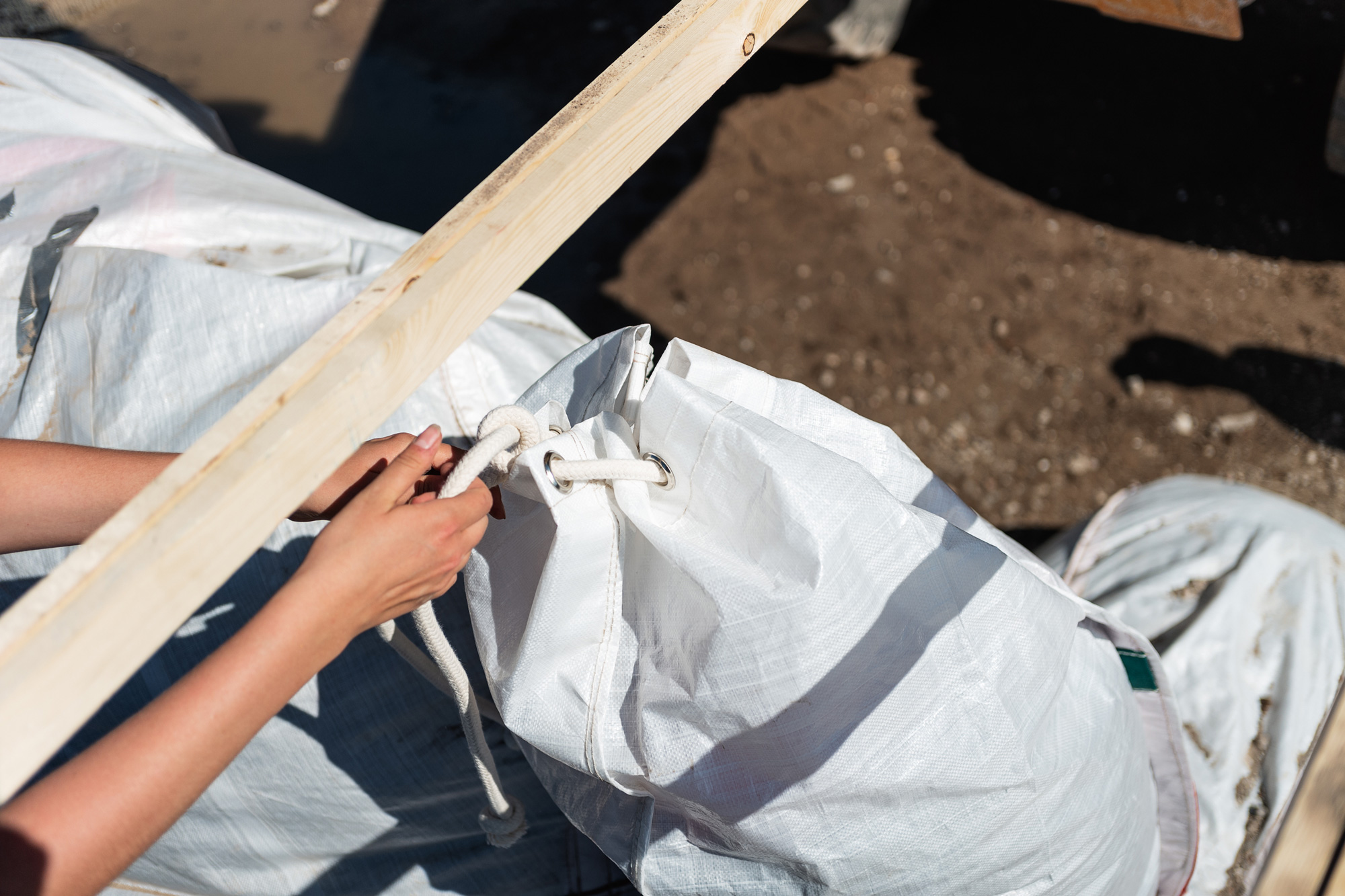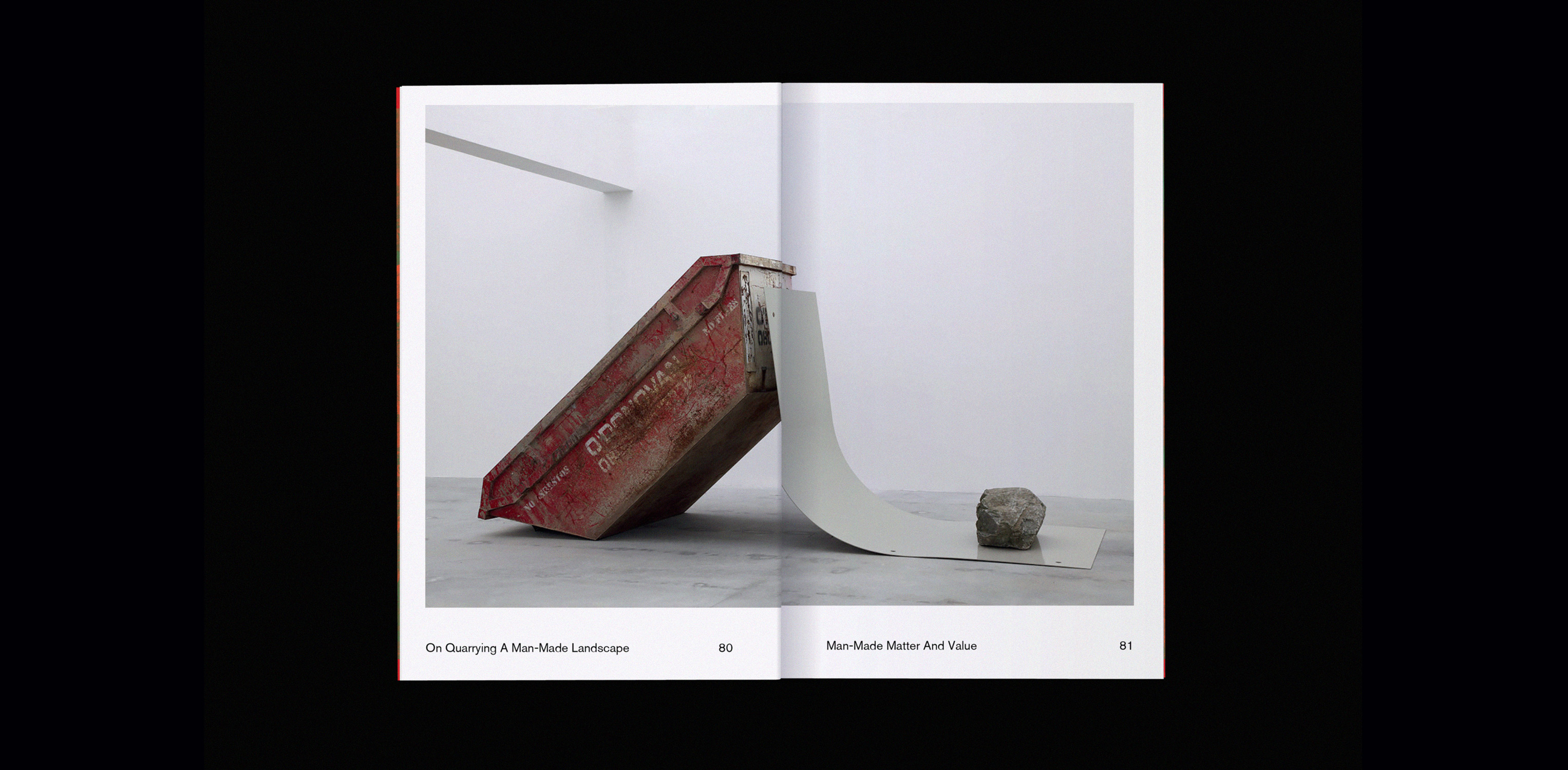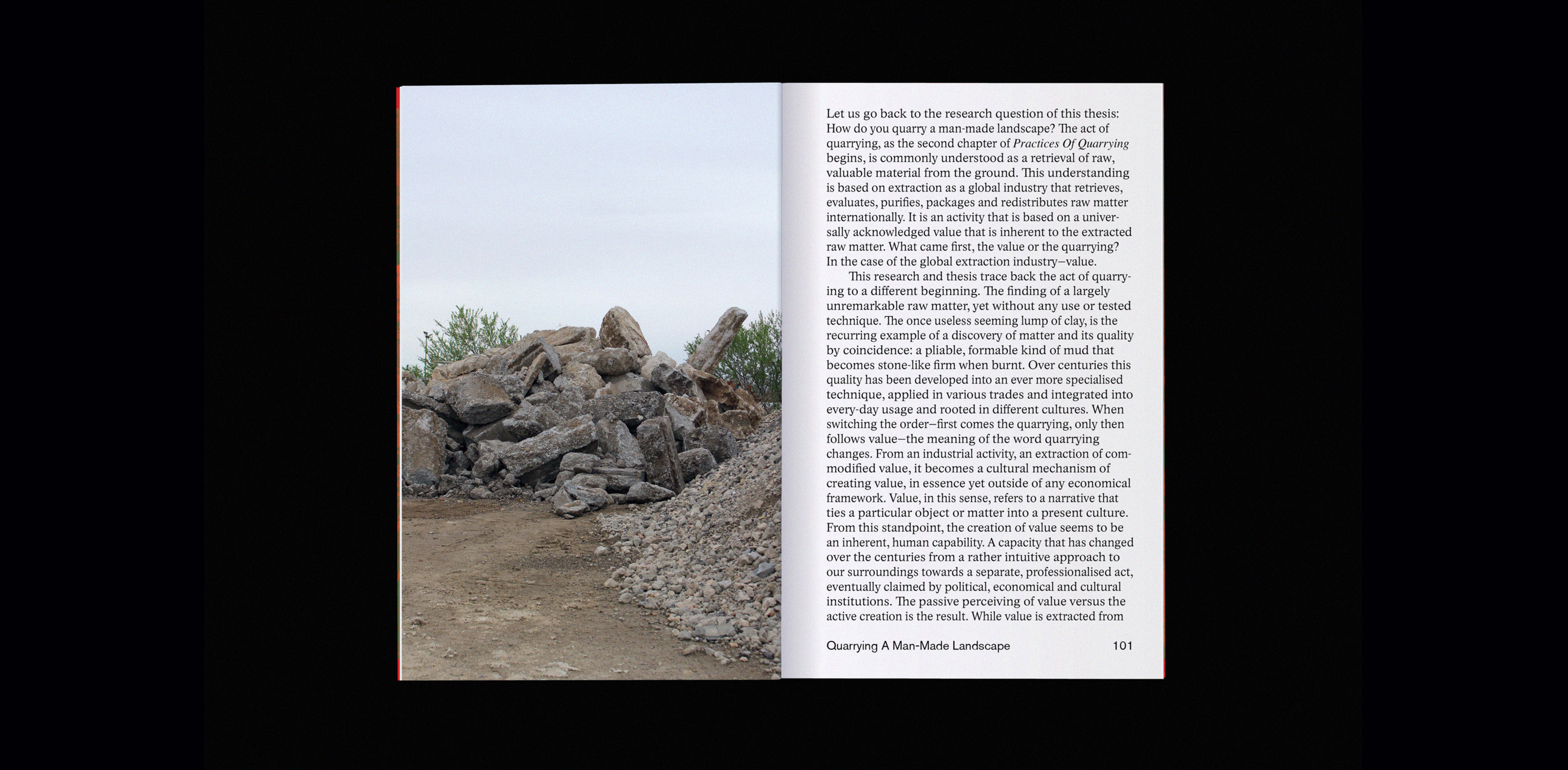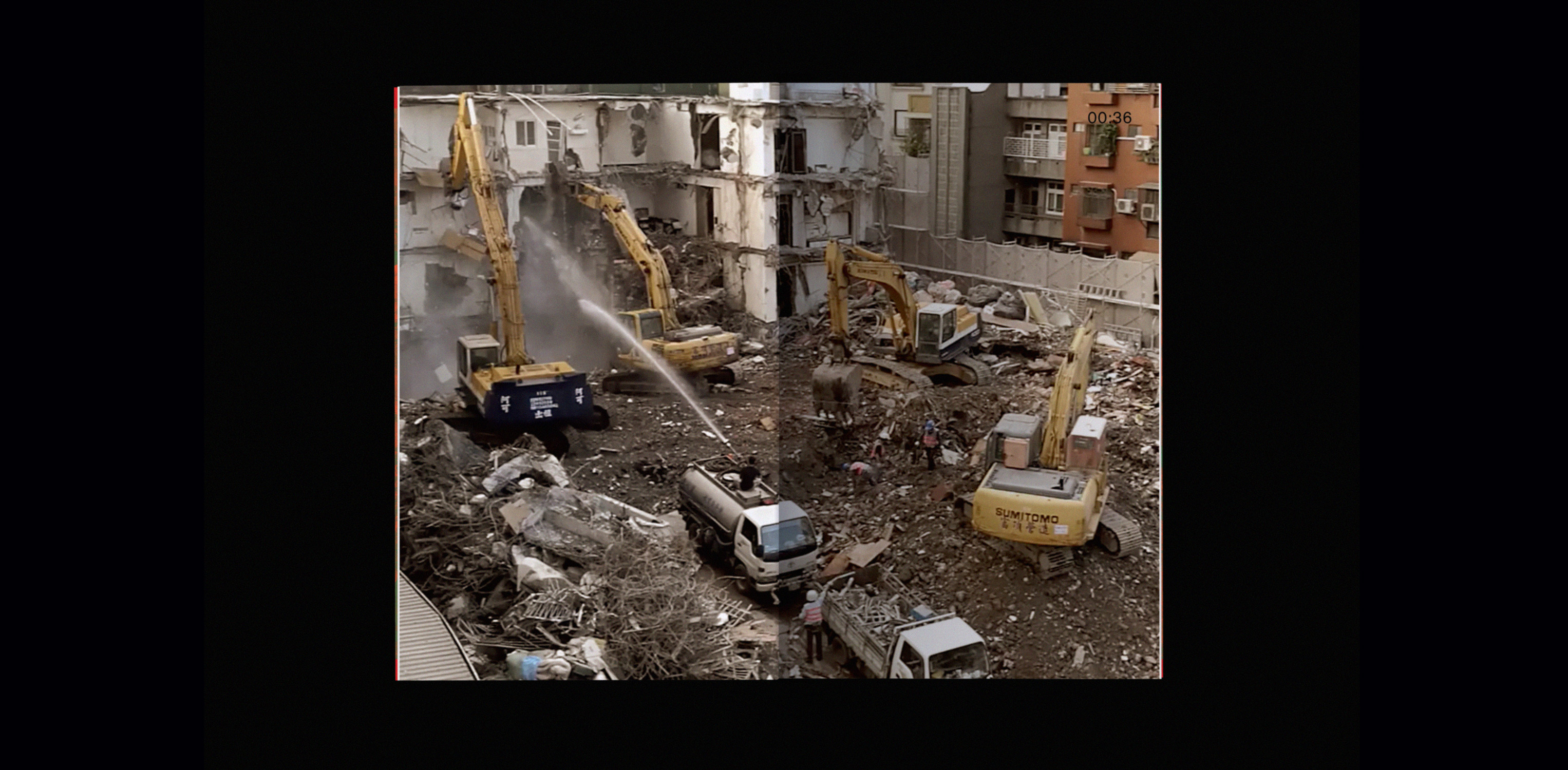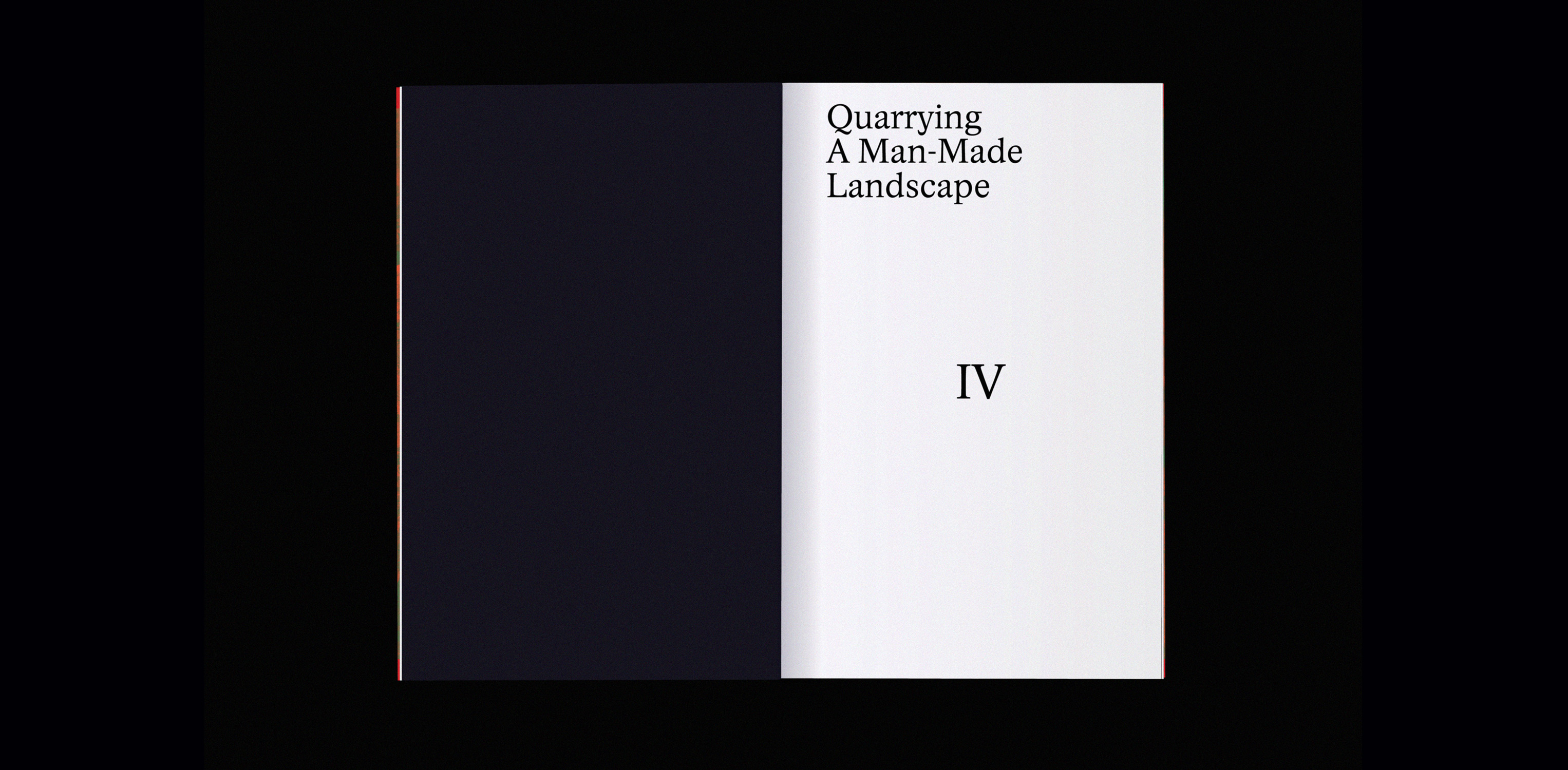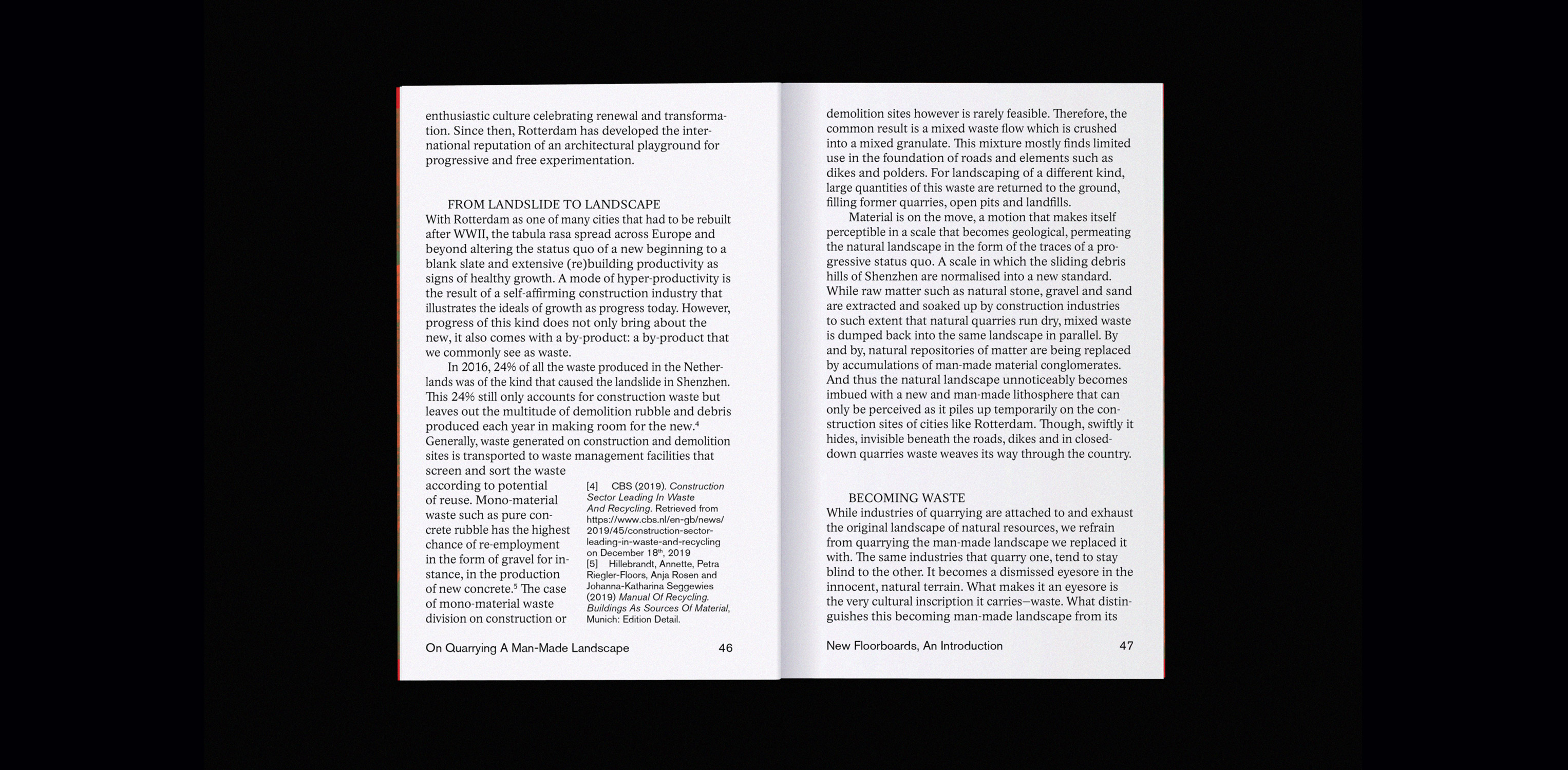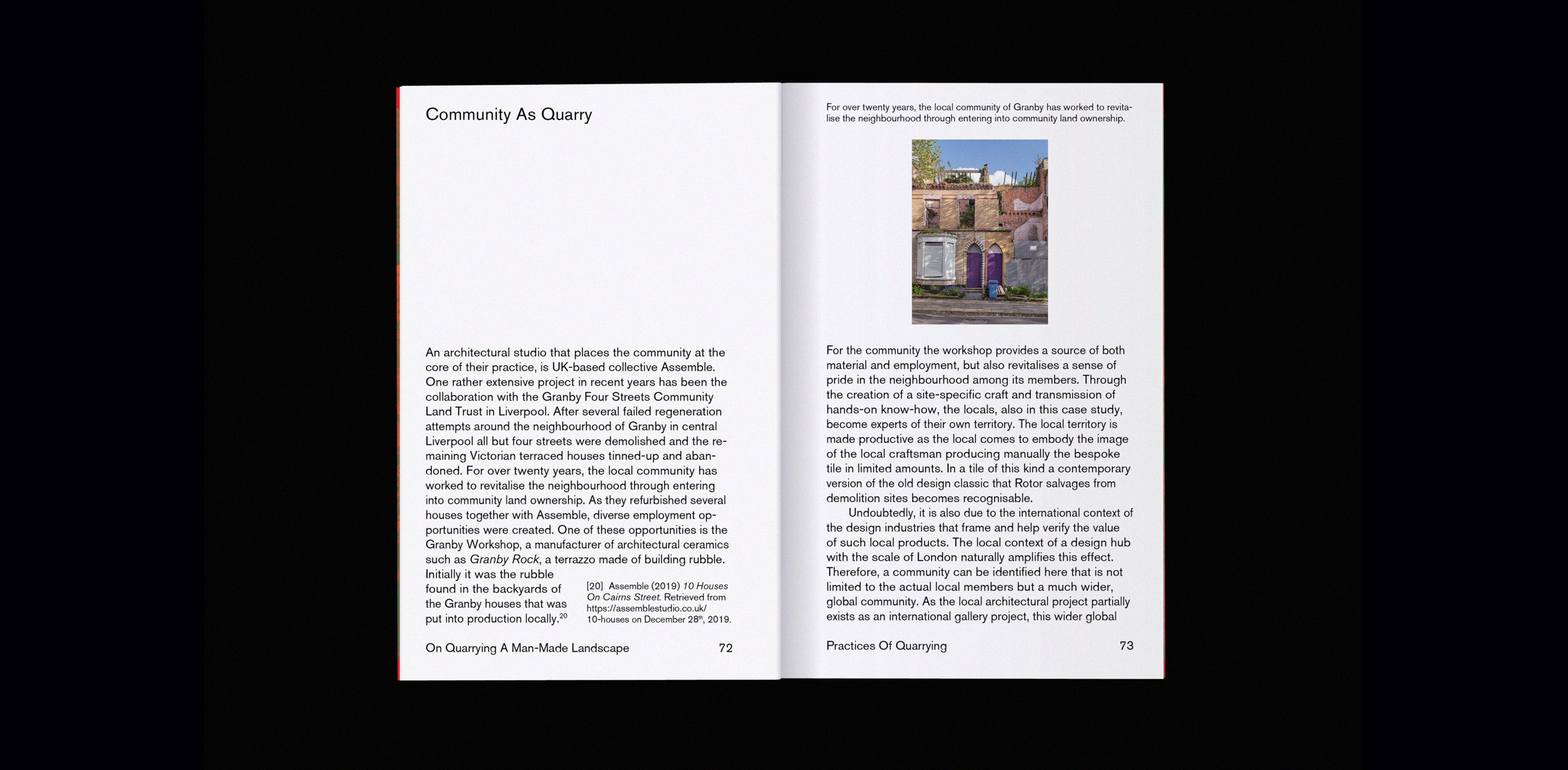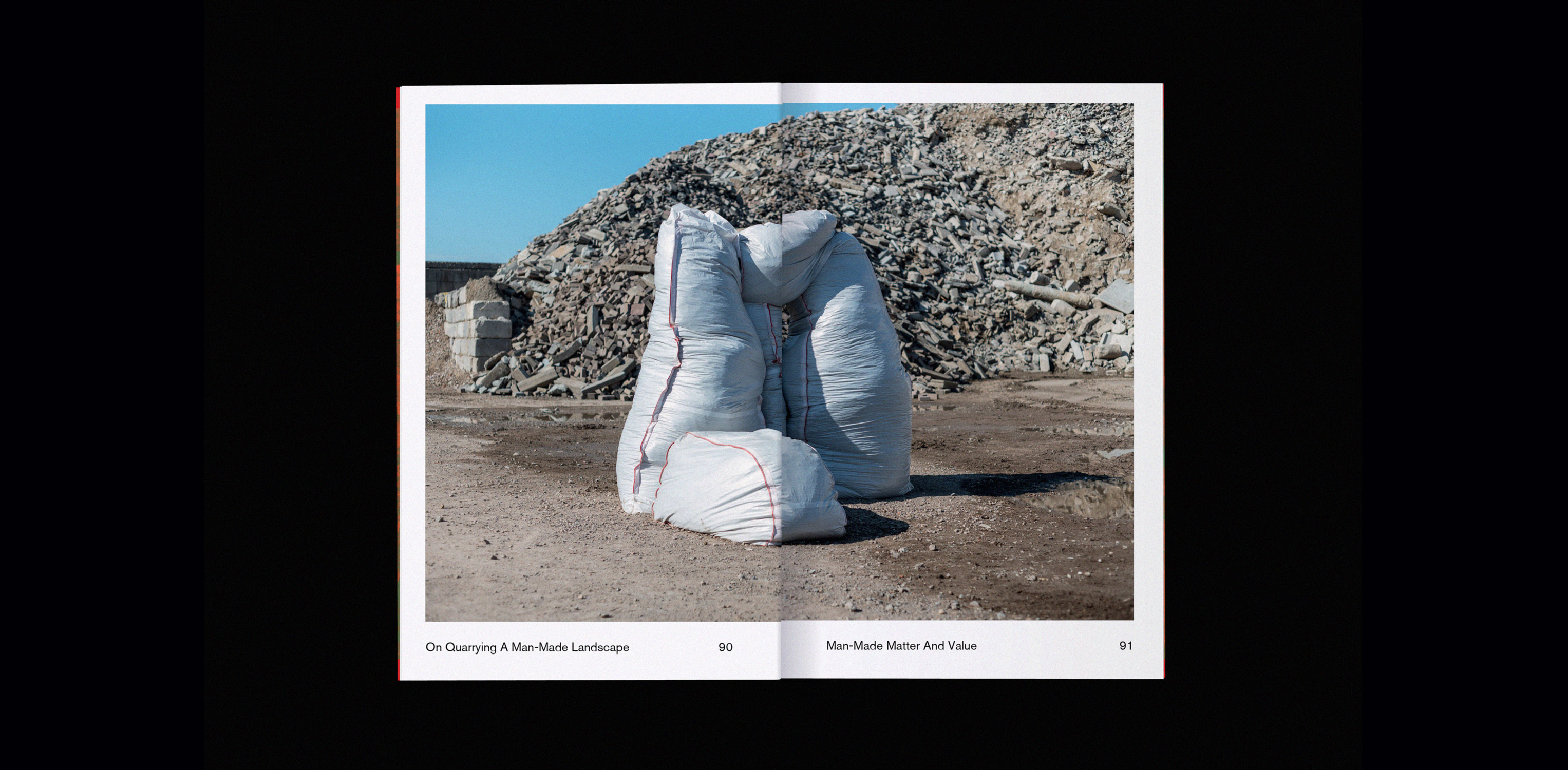Culture in Residency: Material Library
As part of the LINA Fellowship and collaboration with the Institute of Architecture and Design, Estelle Jullian, Thomas Amann, and I held a workshop with the Architecture students of TU Vienna that mapped out the ecological and industrial material landscape around the Campus of the Vienna Boys’ Choir. From these resources the students developed material recipes that would apply these so-called waste streams in a library of local architectural materials.

The Material Library has now permanently moved into the pig sty on the Campus of the Vienna Boy’s Choir in Sekirn, Austria, to inspire and inform future workshops.
How can we live – and create – on a damaged planet? If, as the philosopher Baptiste Morizot describes, the ecological crisis is also a crisis of sensitivity, how can we feel, understand and weave new relationships with respect to the territory and the matter of the objects that constitute our own daily life and the more-than-human life that surrounds us? As the architect tests the role of the mediator to help foster these connections, which tools, methodologies and (knowledge) collaborators are needed and which architectural possibilities spring from this framework?
The slowly deteriorating existing buildings and varied landscape of the Vienna Boys’ Choir campus offer a testing ground for radical strategies of adaptive reuse through local resources and material waste streams. The workshop explored the local landscape that is characterized by its partially natural and its partially industrial material and waste streams. The students mapped these local material streams directly on the territory and in regional proximity to Sekirn to trace the resources for our workshop.

The library includes several died textile samples and liquid pigments extracted from local invasive plant species.
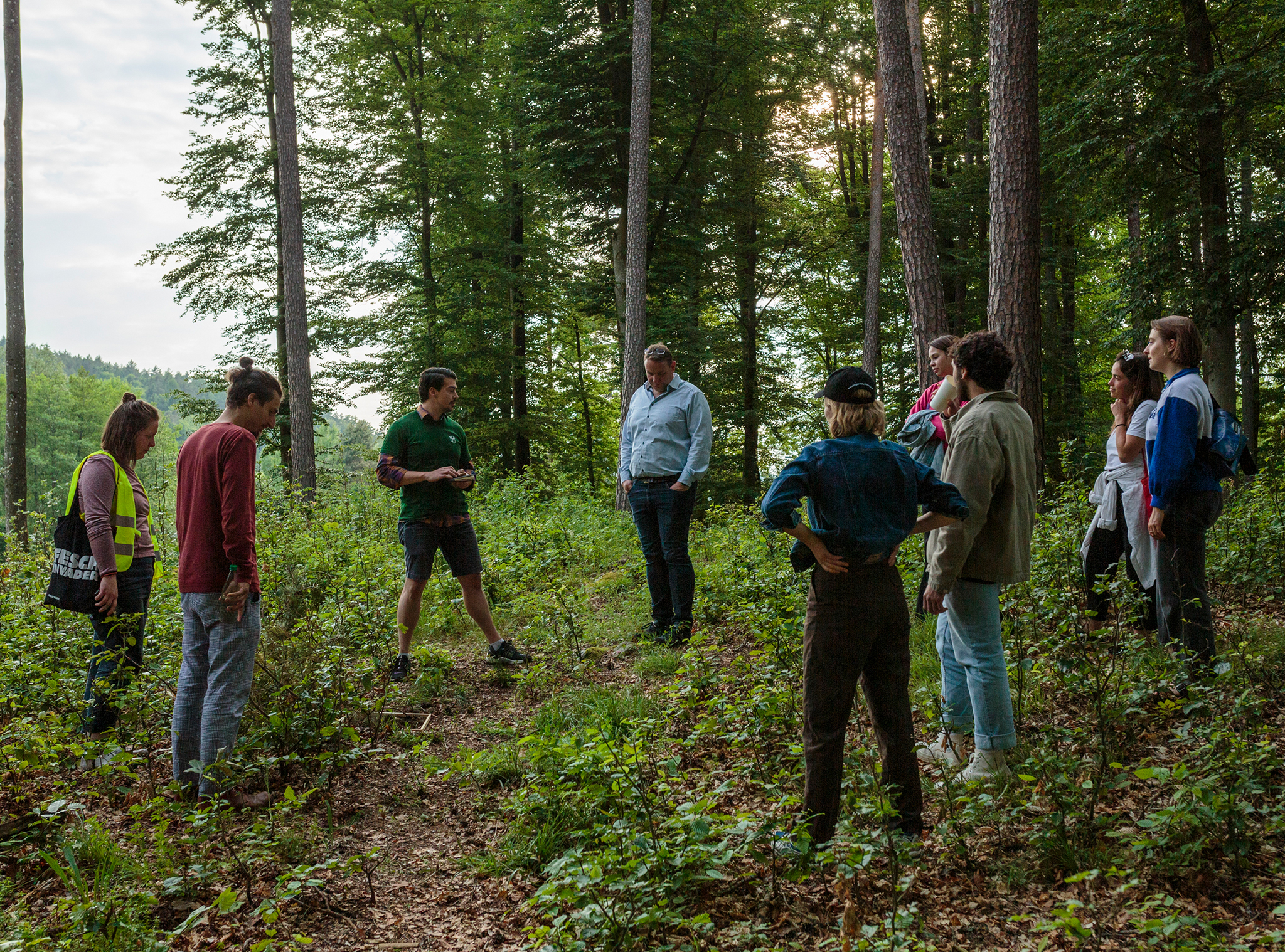
The Material Library is closely connected to the territory that houses it. Tours of the territory reveal these connections between the local ecology of the soil, lake and forrest to the material palette.
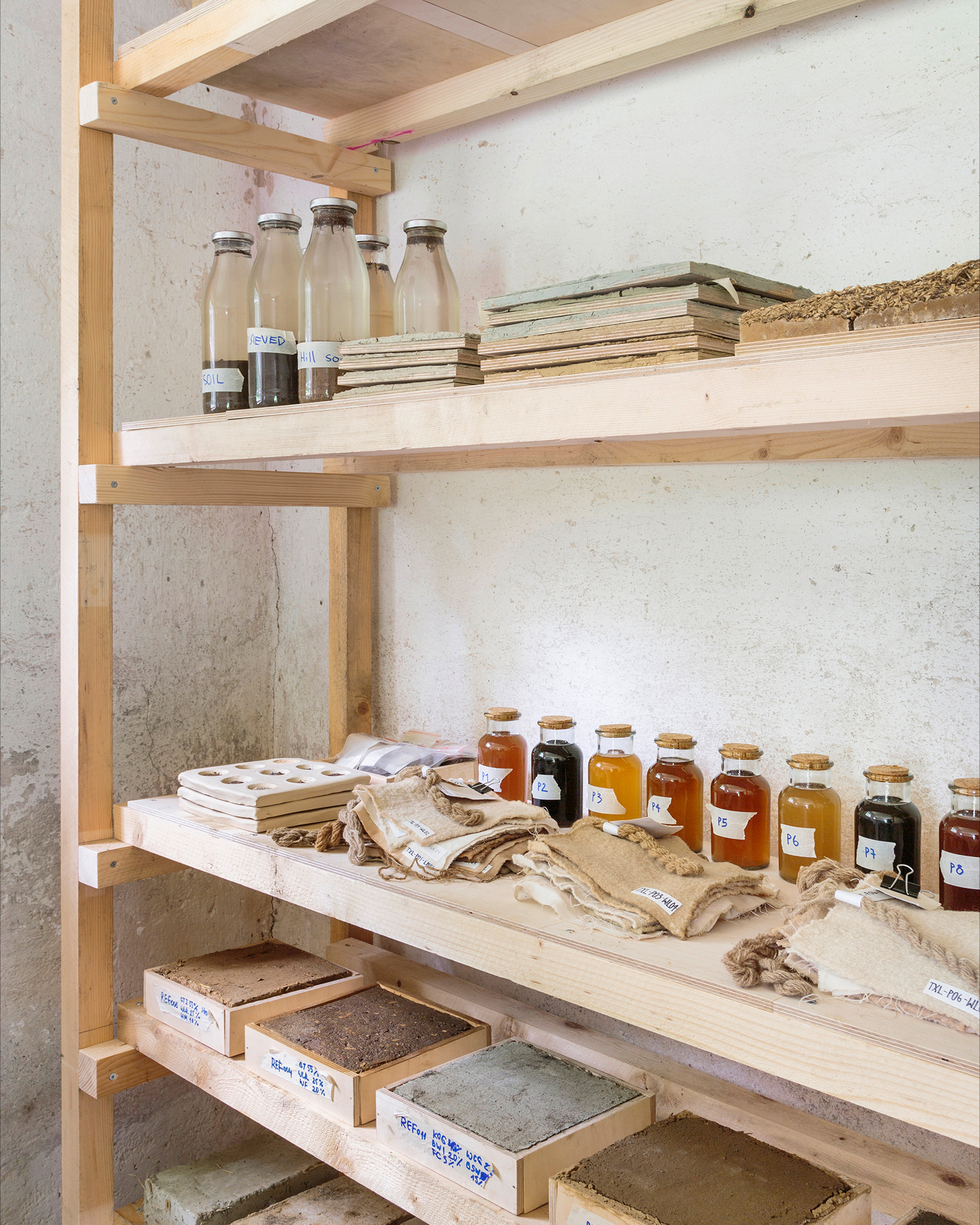
The samples contain both successful and failed experiments to inform future material research.
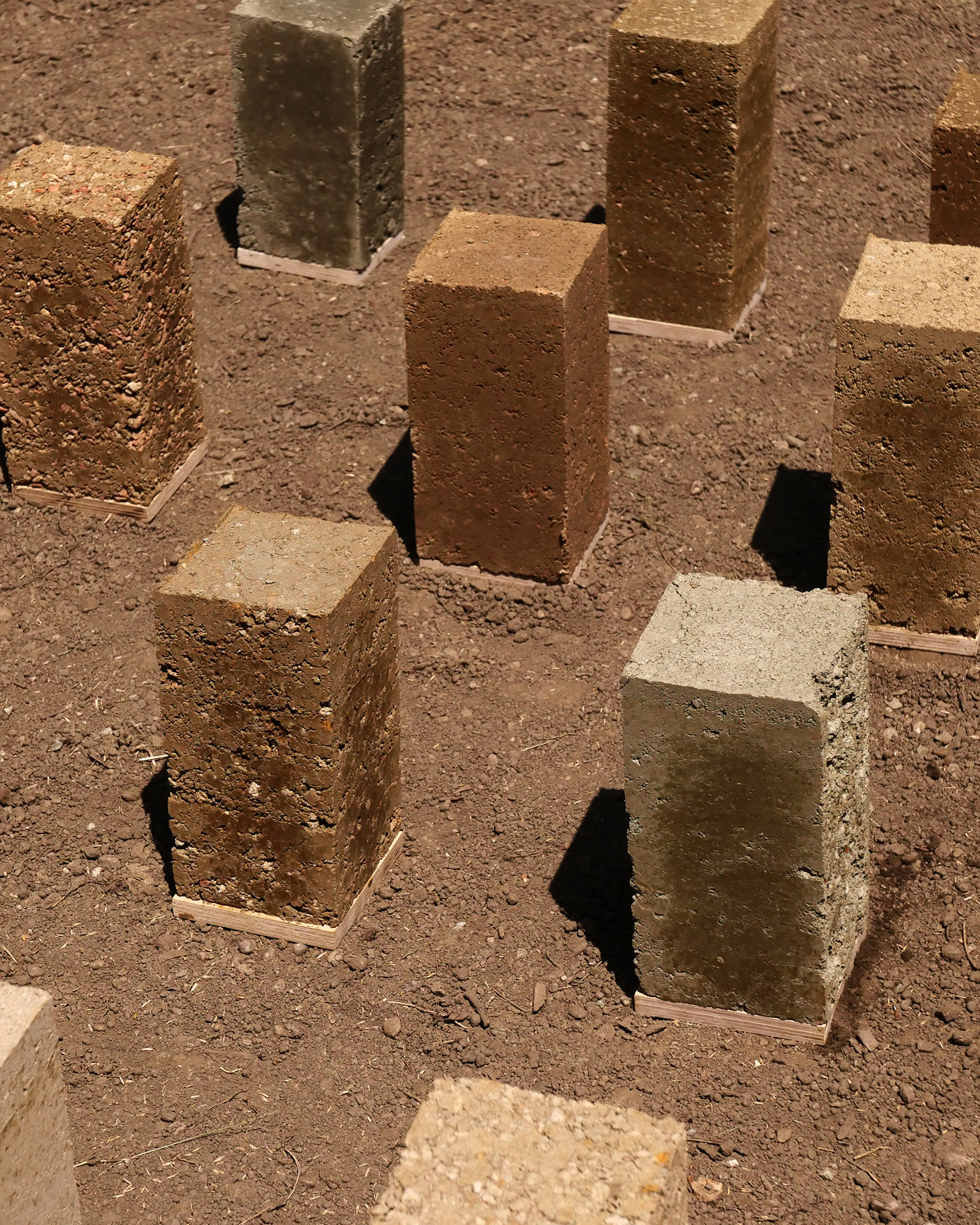
The students tested the use of crushed brick waste, stone dust, and mixed crushed construction waste among other local material streams in the development of a local rammed earth recipe.

All recipes began with a collection of raw material samples from agricultural and industrial (waste) material streams like the invasive Japanese knotweed, waste sheep wool, or crushed construction waste.
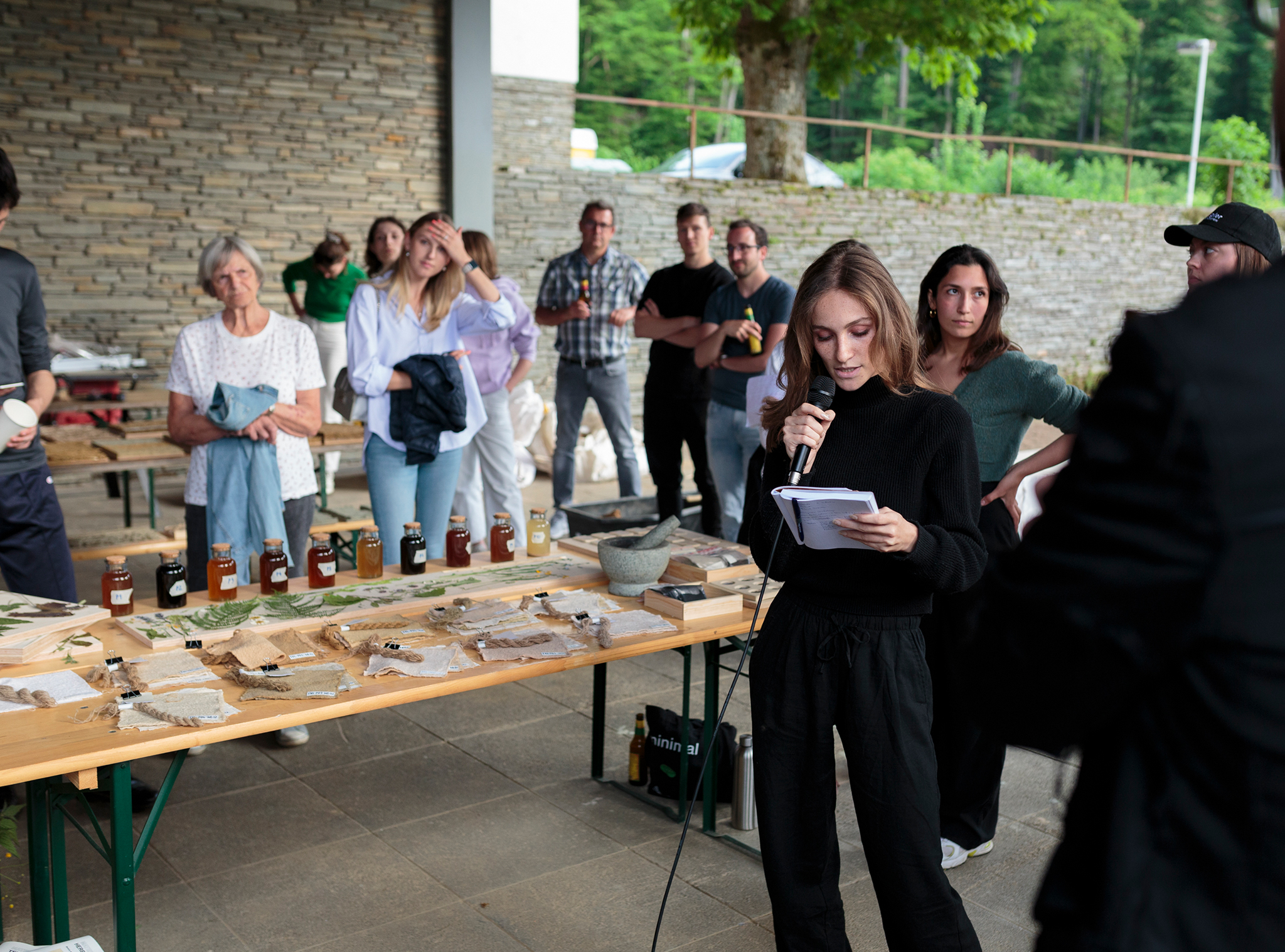
At the opening of the Material Library, the students guide their material partners, neighbours and tutors through their process.
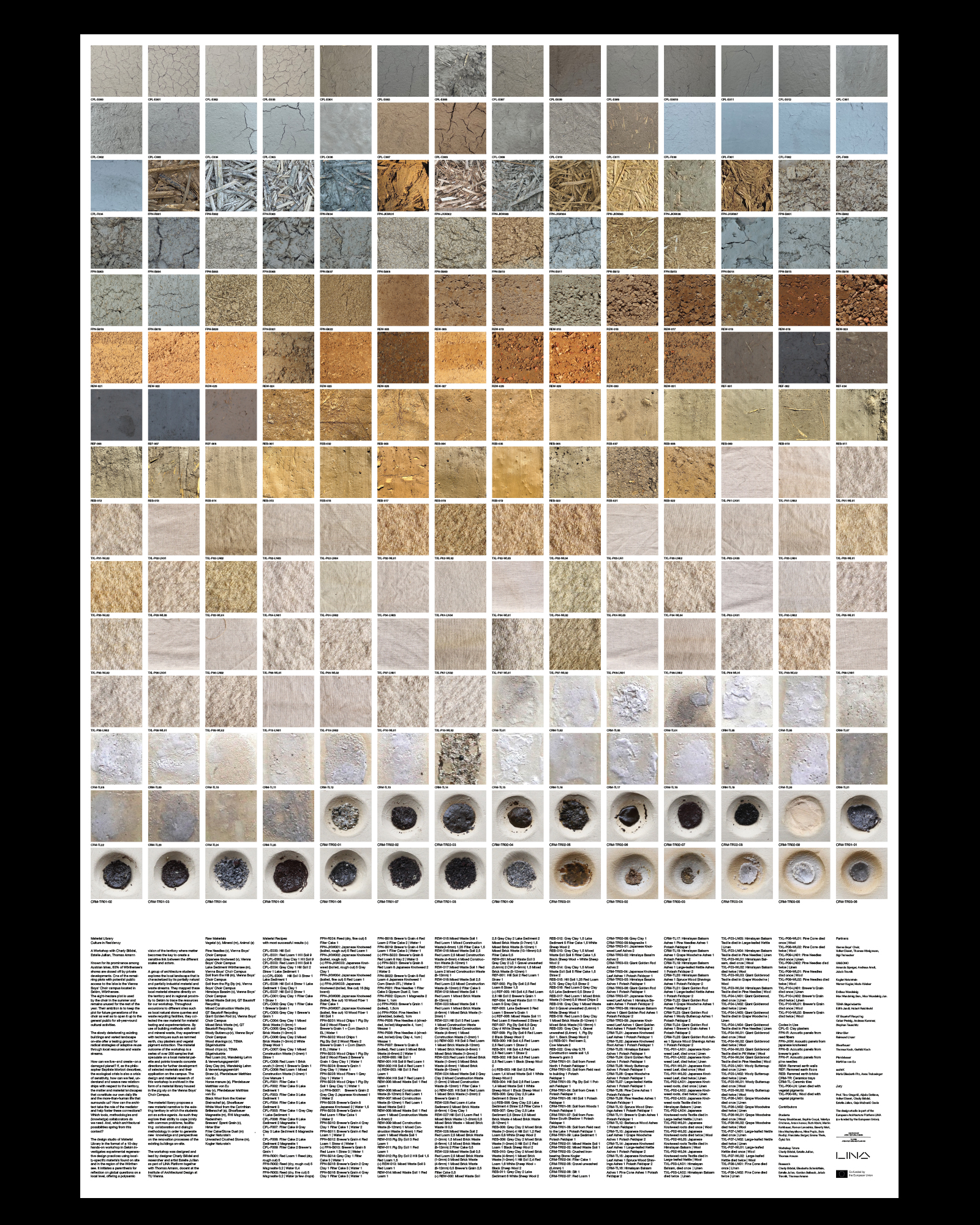
All material recipes, both failures and successes, are noted and archived in a recipe poster.
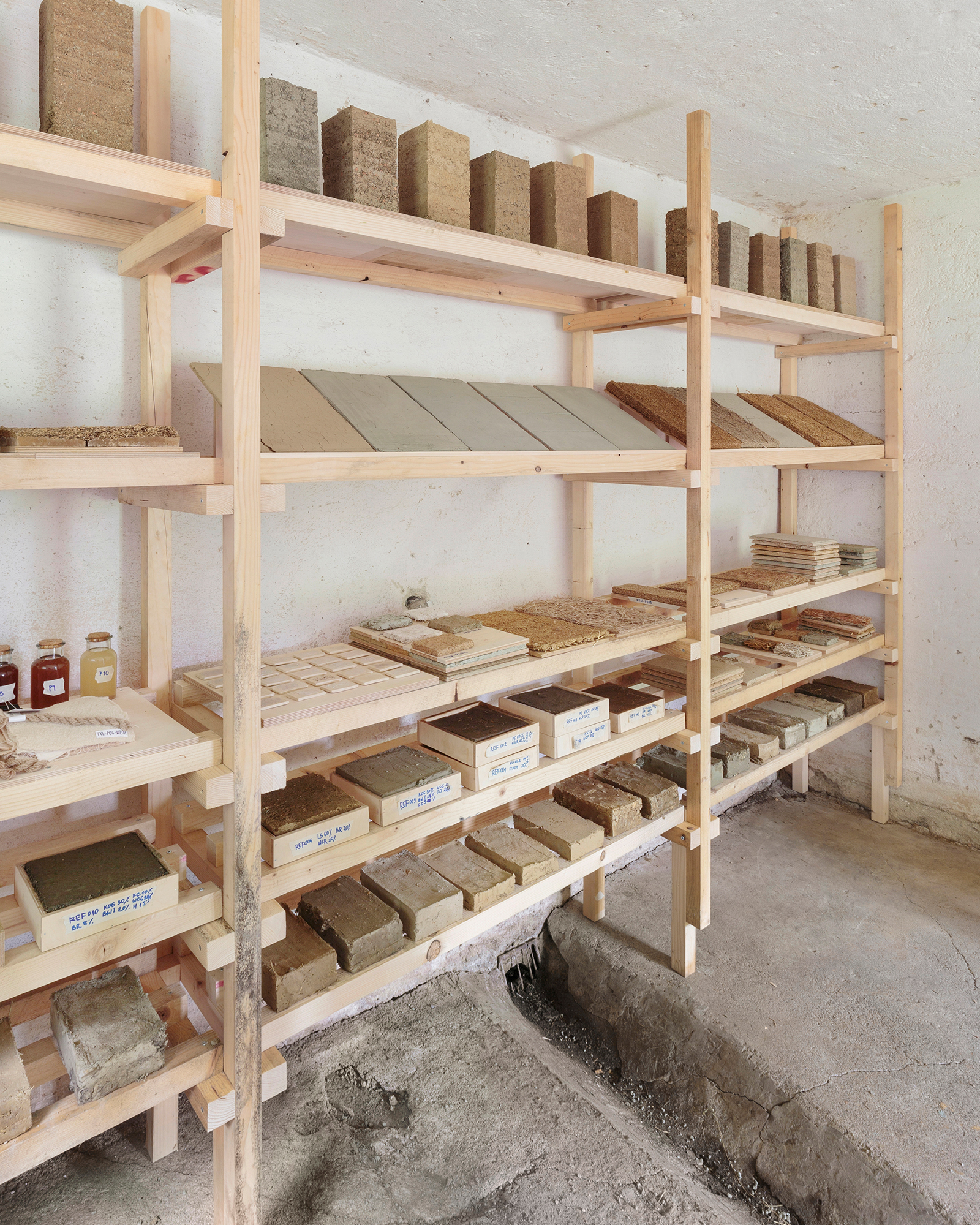
Throughout excursions to different sites such as local natural stone quarries and construction waste recycling facilities, we collected the raw material for material testing and experimentations. The outcome of the workshop is a series of material samples that speculate on a local material palette. These samples point towards concrete directions for further development of selected materials and their application on the campus. The design and material research of this workshop is archived in the form of a library for local material recipes which will be housed at the pig sty of the campus for future use and further exploration.
The material library proposes a new material narrative to the existing territory in which the students of TU Vienna act as active agents in coping jointly with common challenges, facilitating collaboration and dialogic methodologies in order to generate and draw on new knowledge(s) and perspectives in the specific context of the renovation processes on the Vienna Boys’ Choir campus.
Students
Fanny Bruckbauer, Sophie Coqui, Valeriya Gridneva, Anton Ivanov, Ruth Köchl, Martin Kohlbauer, Roman Levoshka, Beverly Mori, Irina Mezheynikova, Nina Popic, Sara Rodiqi, Franziska Sorger, Emma Theis, Öykü Tok
Workshop Tutors
Charly Blödel, Estelle Jullian, Thomas Amann
Jury
Prof. Tina Gregorič Aljoša Dekleva, Volker Dienst, Tina Gregorič, Estelle Julian, Gaja Mežnarić Osole
The design studio is part of the European Architecture Platform LINA (co-funded by the European Union).

© Charly Blödel, 2022. For more Imprint.
Building with Waste Streams
During a 10-day workshop developed with Estelle Jullian (LINA fellow) and Thomas Amann (TU Vienna), the Architecture Master Students mapped local agricultural waste streams and industrial byproducts in natural stone quarries, construction waste recycling facilities and wood manufacturers. Through material tests and prototyping, the students developed new material recipes that apply these material streams in a local architectural material palette, from recipes for rammed earth walls, bricks, earthen floors to ceramic Glaces and textiles died with invasive plants.

The quarry of Kogler Naturstein offers a range of products from natural stone slabs and crushed stone in various sizes. When stone is crushed and machines are cleaned, a fine stone dust is filtered out of the cleaning water: A filter cake that the students made use of in rammed earth, brick and plaster mixtures.
How can we live – and create – on a damaged planet? If, as the philosopher Baptiste Morizot describes, the ecological crisis is also a crisis of sensitivity, how can we feel, understand and weave new relationships with respect to the territory and the matter of the objects that constitute our own daily life and the more-than-human life that surrounds us? As the architect tests the role of the mediator to help foster these connections, which tools, methodologies and (knowledge) collaborators are needed and which architectural possibilities spring from this framework?

From crushed brick to stone dust and invasive Japanese knotweed the students explore these materials not as agricultural and industrial waste streams but as possible material streams that can be valuable in the development of local architectural materials.
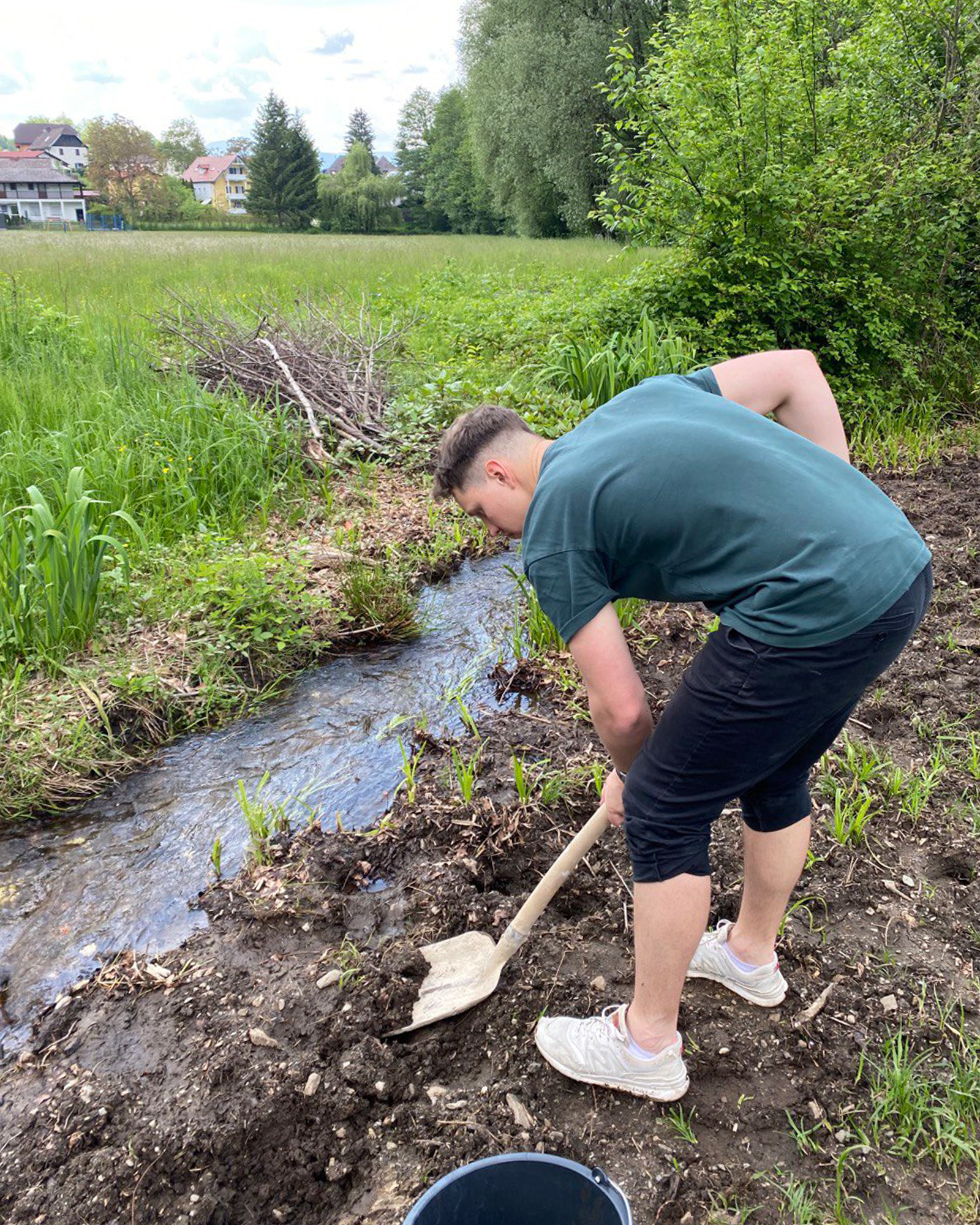
Different kinds of soil can be found on the Campus of the Vienna Boys’ Choir. Each location offers different properties in soils.

With a bottle test the students explore the properties of soils found on the territory of the Campus and waste soils from recycling sites.

The recipes reach from earthen walls and floors to ceramic glazes and died textiles.
The slowly deteriorating existing buildings and varied landscape of the Vienna Boys’ Choir campus offer a testing ground for radical strategies of adaptive reuse through local resources and material waste streams. The workshop explored the local landscape that is characterized by its partially natural and its partially industrial material and waste streams. The students mapped these local material streams directly on the territory and in regional proximity to Sekirn to trace the resources for our workshop.
Throughout excursions to different sites such as local natural stone quarries and construction waste recycling facilities, we collected the raw material for material testing and experimentations. The outcome of the workshop is a series of material samples that speculate on a local material palette. These samples point towards concrete directions for further development of selected materials and their application on the campus. The design and material research of this workshop is archived in the form of a library for local material recipes which will be housed at the pig sty of the campus for future use and further exploration.

Through frequent adjusting of ratios and testing of material properties, the students refine their final recipes.
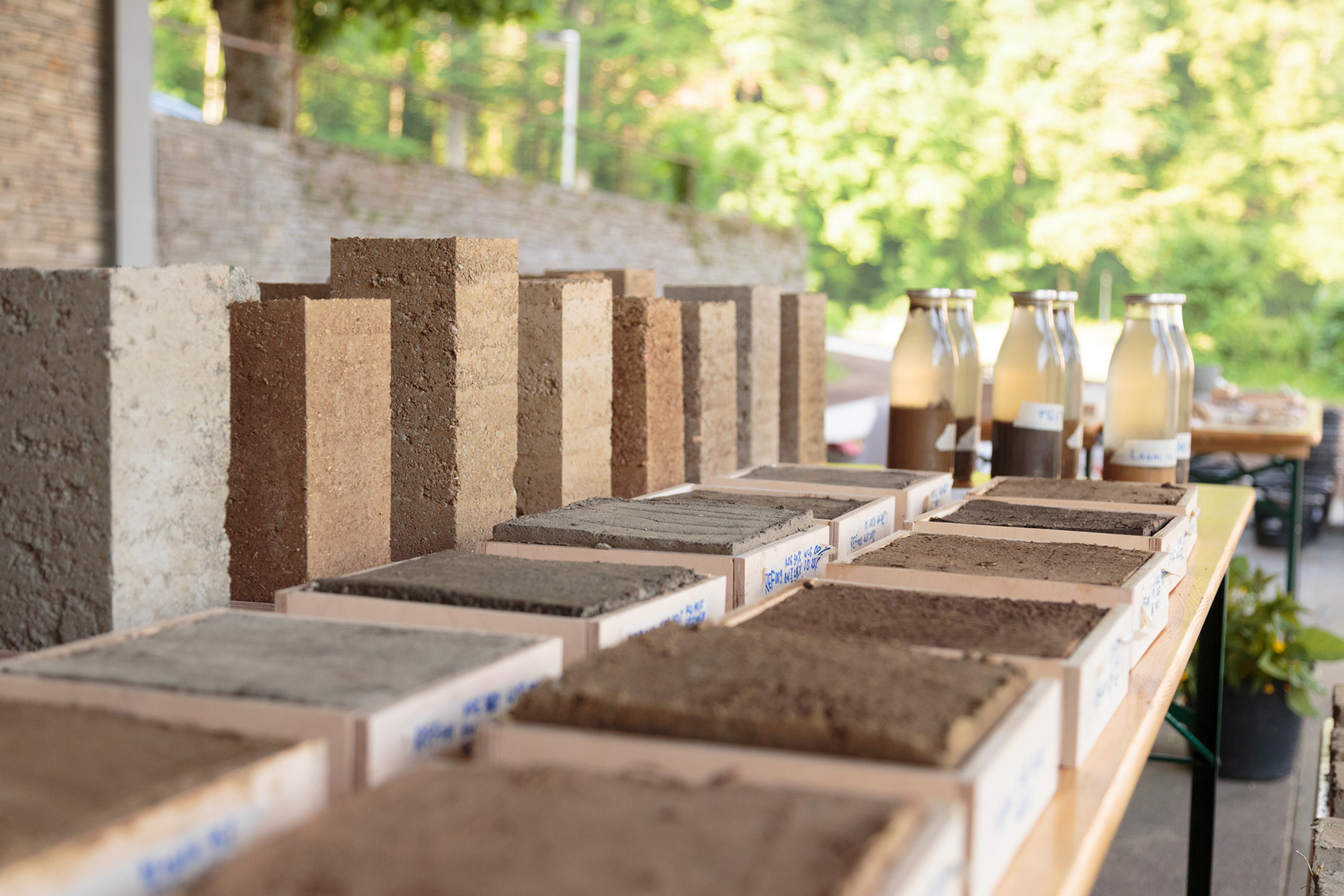
The result: a material library of industrial waste streams applied in a local architectural material palette.
The material library proposes a new material narrative to the existing territory in which the students of TU Vienna act as active agents in coping jointly with common challenges, facilitating collaboration and dialogic methodologies in order to generate and draw on new knowledge(s) and perspectives in the specific context of the renovation processes on the Vienna Boys’ Choir campus.
Students
Fanny Bruckbauer, Sophie Coqui, Valeriya Gridneva, Anton Ivanov, Ruth Köchl, Martin Kohlbauer, Roman Levoshka, Beverly Mori, Irina Mezheynikova, Nina Popic, Sara Rodiqi, Franziska Sorger, Emma Theis, Öykü Tok
Workshop Tutors
Charly Blödel, Estelle Jullian, Thomas Amann
Jury
Prof. Tina Gregorič Aljoša Dekleva, Volker Dienst, Tina Gregorič, Estelle Julian, Gaja Mežnarić Osole The design studio is part of the European Architecture Platform LINA (co-funded by the European Union).
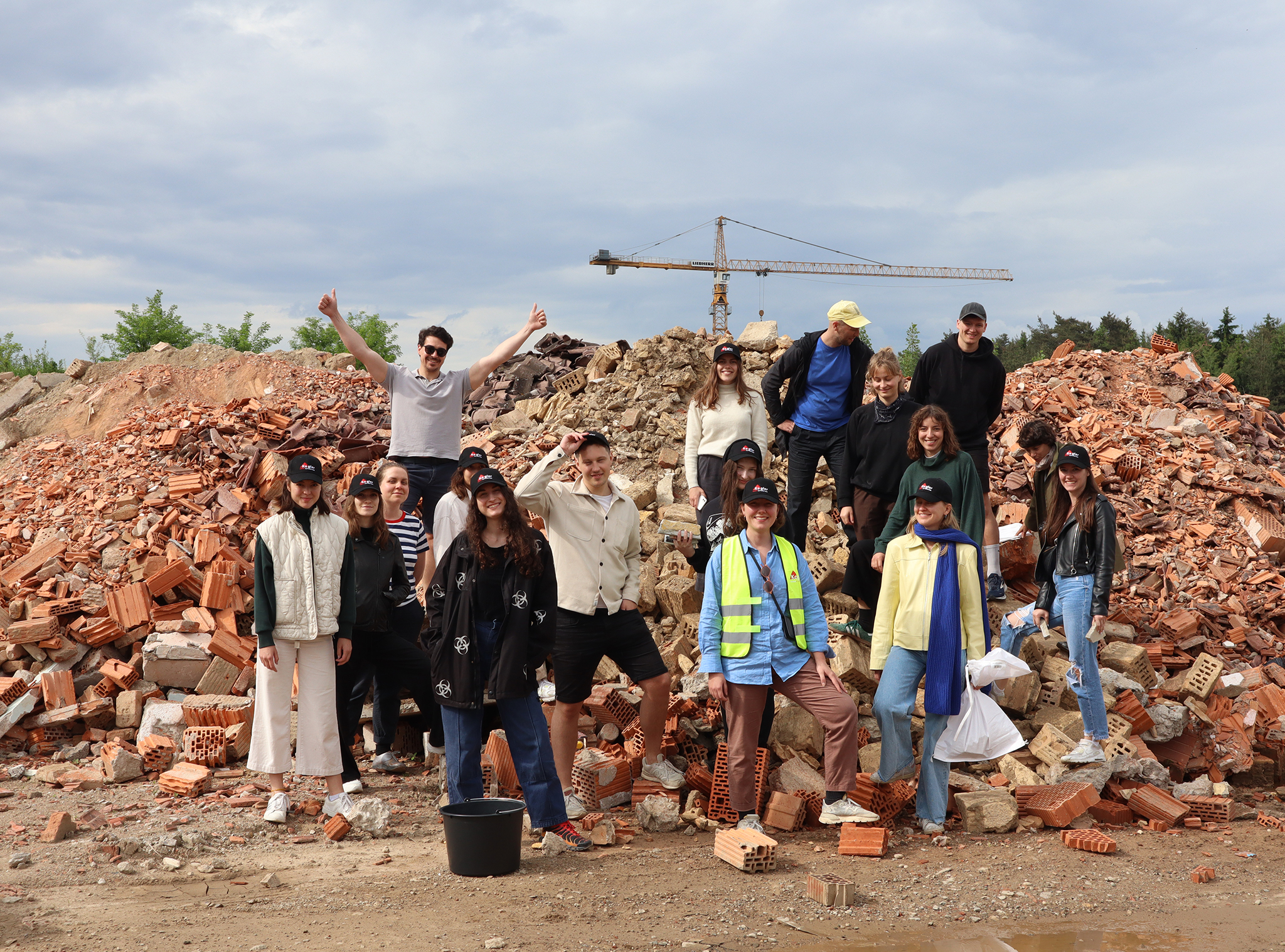
The students of the Institute of Architecture and Design, TU Vienna, with tutors Thomas Amann, Estelle Jullian and Charly Blödel during one of the excursions to GT Baustoff Recycling.
© Charly Blödel, 2022. For more Imprint.
Design studio: One More Time With Feeling
How can we make buildings again from the buildings we demolish? What architecture can we imagine, if fragments, rubble and debris are the main building blocks? The studio ‘One More Time With Feeling’ at the Rotterdamse Akademie van Bouwkunst in Rotterdam proposes reuse as a conceptual approach to architecture and practices of building or un-building. During the semester, large plaster models of generic building structures were made through which the process of demolition was simulated to scale and served as the material basis for making a design.

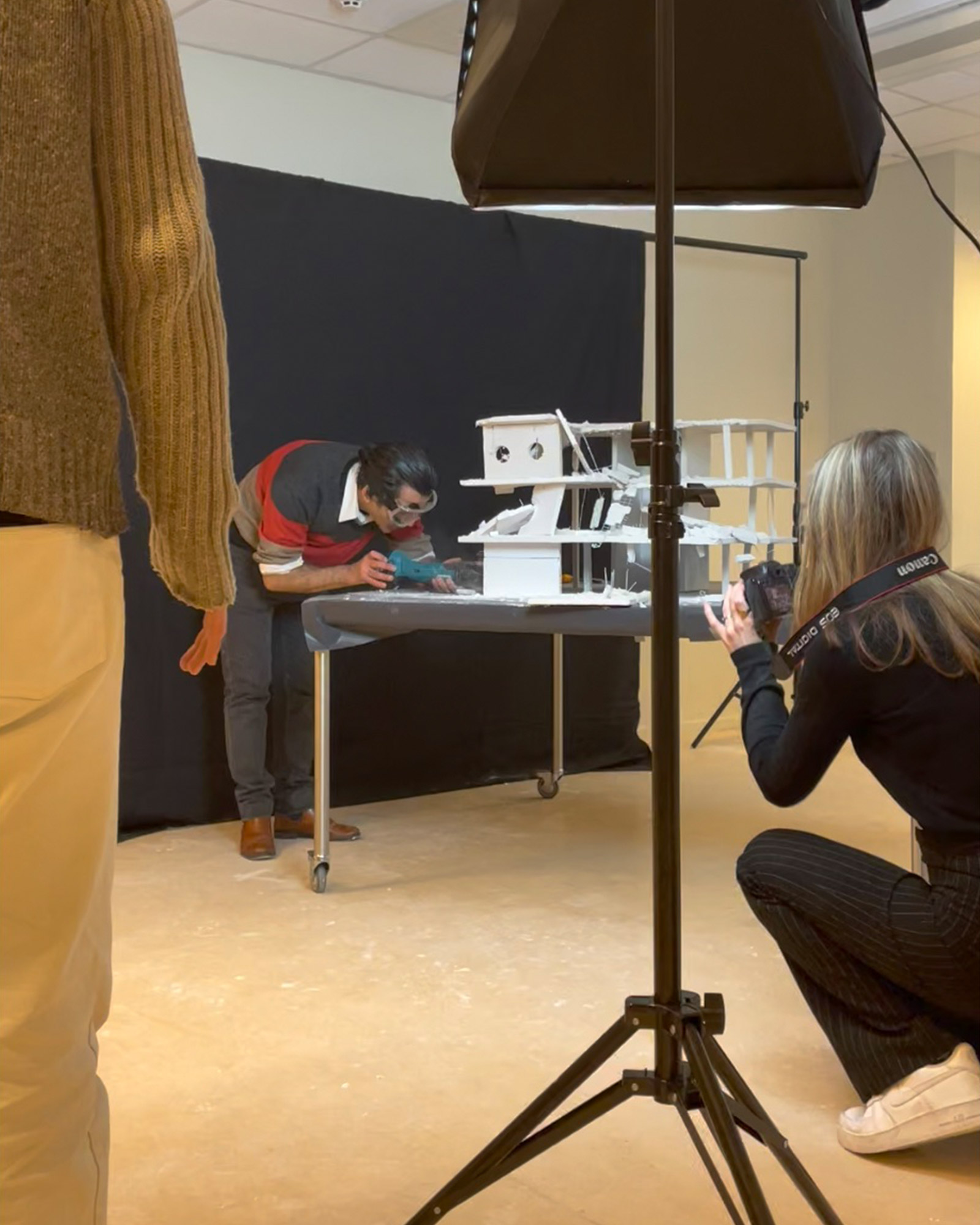
Students
Jurrian Blom, Shamal Soltani, Seyed Farzad Hosseini, Corne bij de Vaate, Joris Warndorff, Jorien Rijper, Elias T’Joens, Anne Spanjaards, Linde Spuijbroek, Merve Coban
Tutors
Tomas Dirrix, Julia Strömland, Charly Blödel, Bas Leemans
Visiting critic
Laura van Santen, Ladida Architects
© Charly Blödel, 2022. For more Imprint.
KLUTZ: (Zoom) Lecture & Open Call
As a prelude to the Architekturwoche Basel 2022, Charly Blödel will give a (zoom) lecture (in German) on 21 April, 17:30–18:30 at FHNW, Basel (CH).
In tandem with the lecture Team KLUTZ launches an Open Call for students to participate in the performative build-up on 6 and 7 May, 2022, at the Basel Pavillon, the main location of the Architekturwoche Basel 2022 where KLUTZ will become a meeting point and forum for panel discussions, interviews and lectures throughout AWB from 09–15 May and summer programme 2022.
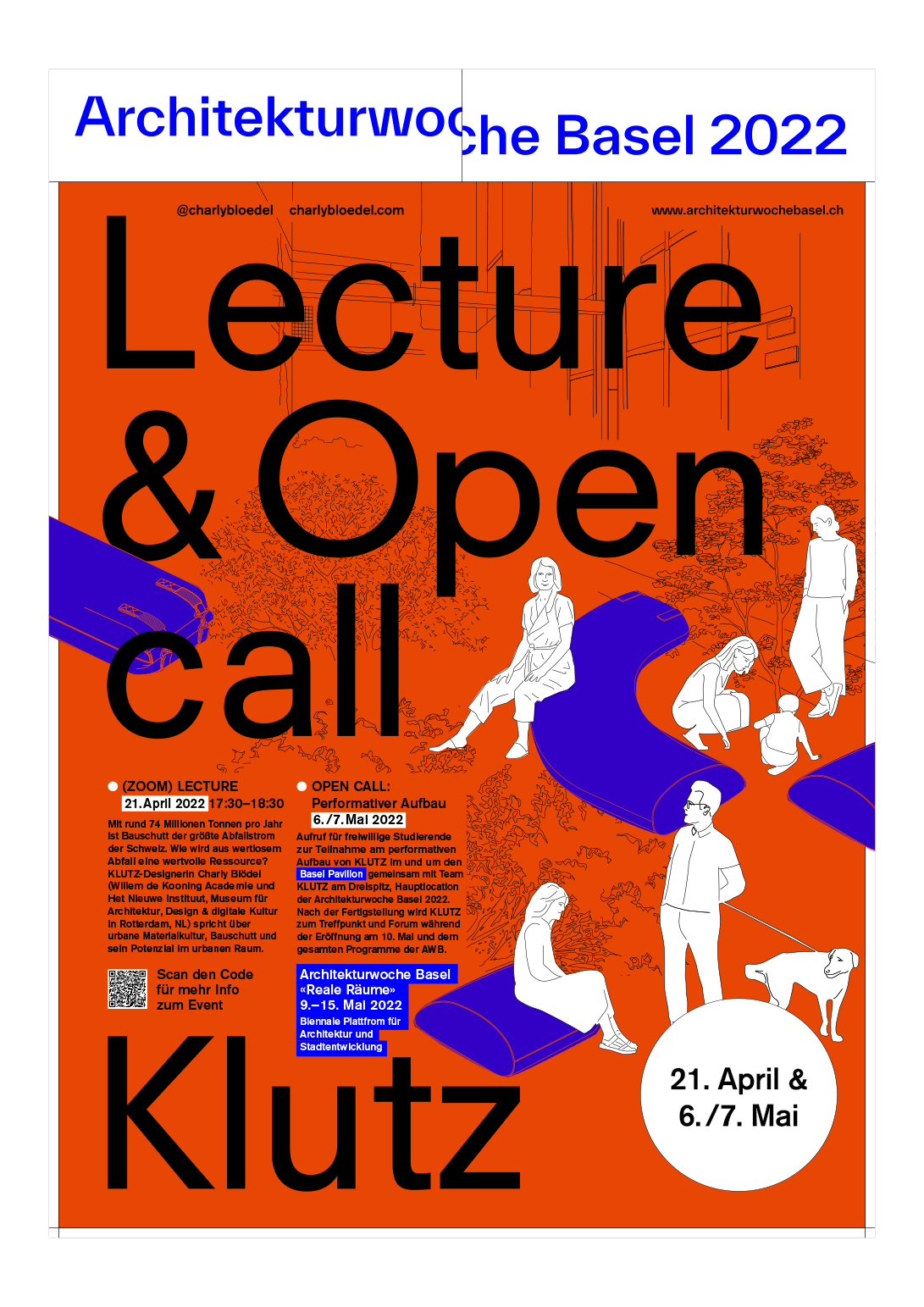
(ZOOM) LECTURE
21 April, 2022, 17:30–18:30
At around 74 million tons per year, construction waste is the largest waste stream in Switzerland. How do you turn worthless waste into a valuable re-source? KLUTZ-designer Charly Blödel (Tutor at Willem de Kooning Academie and programme and exhibition producer at Het Nieuwe Instituut, Museum for Architecture, Design & e-Culture in Rotterdam, NL) talks about material culture, construction waste and its potential to return to the public sphere.
SIGN UP for the lecture via Eventbrite.
OPEN CALL
6/7 May, 2022
On 6 and 7 May, 2022, Team KLUTZ will set up the temporary urban furniture cluster KLUTZ in and around the Basel Pavillon at Dreispitz. We invite student volunteers to join the team in the performative build-up in preparation for the opening of the Architekturwoche Basel 2022. The Basel Pavillon is the main location of AWB 2022. Once completed, Klutz will become a meeting point and forum at Dreispitz during the opening on 10 May and the entire programme of AWB 2022. Team KLUTZ is looking forward to seeing you!
SIGN UP for the KLUTZ performative build-up during the (Zoom) Lecture on 21 April
or directly via mail to hello@charlybloedel.com.
How does worthless waste become a valuable resource? KLUTZ-designer Charly Blödel talks about urban material culture, construction waste and its potential to return into public space. At around 74 million tons per year, construction waste is the largest waste stream in Switzerland. As mixed construction waste, concrete, brick, tile and asphalt are not used to construct new buildings, but are used as secondary materials to fill depleted quarries and other landscape and infrastructure work. Thus, a material that was originally mined from the natural landscape as a valuable raw material now flows back into a man-made landscape as a worthless waste material. How can worthless waste become a valuable resource? This is the question posed by KLUTZ.
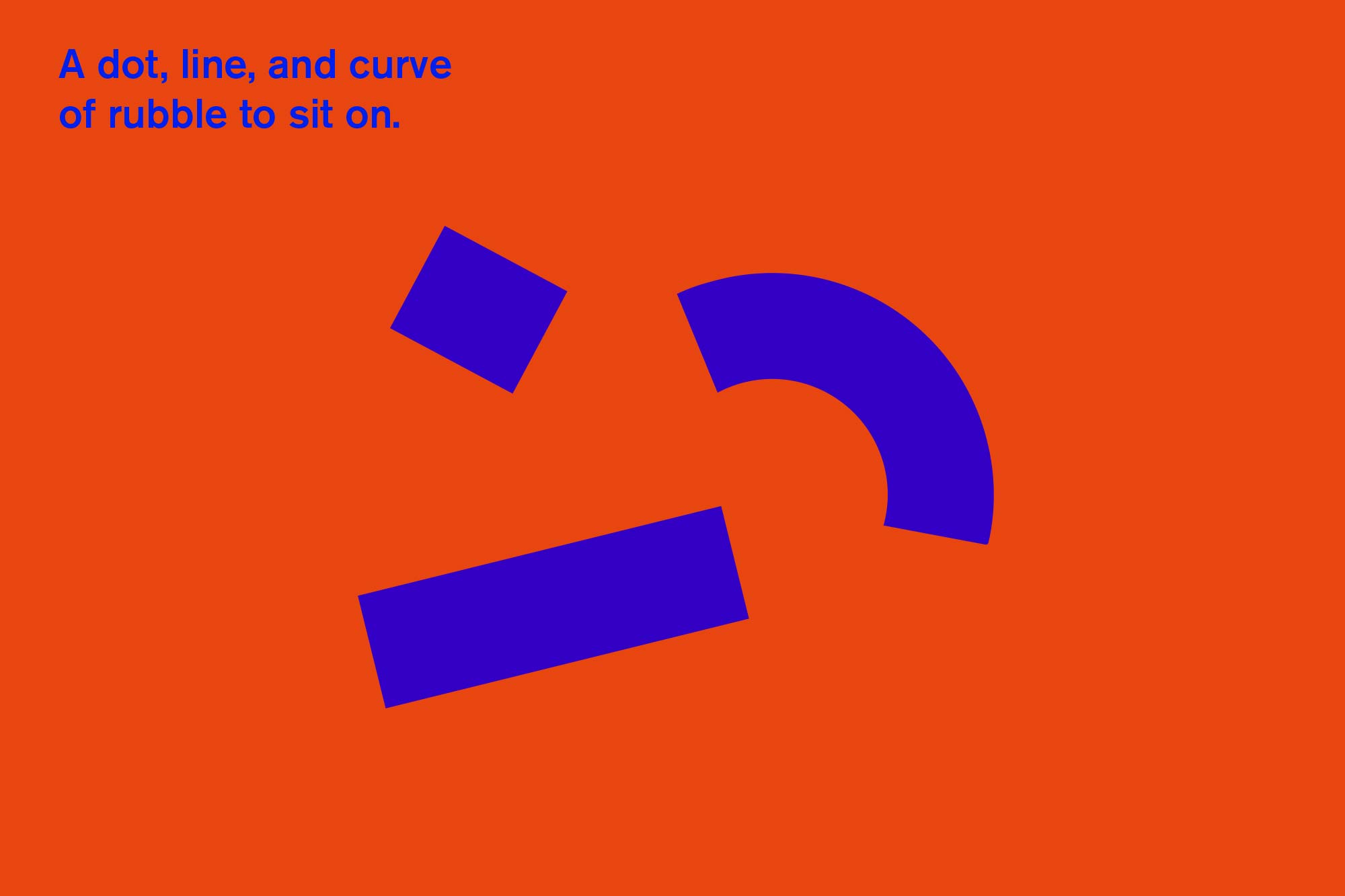
As a bag-module, KLUTZ will provide the context for panel discussions, interviews and lectures at the Basel Pavillon, the main location of the Architekturewoche Basel 2022.
KLUTZ is an urban furniture made of textile, on show for the first time during Architekturwoche Basel 2022. However KLUTZ only becomes a seat when it is filled with construction waste. As a bag module, KLUTZ is easy to transport, empty and refill. This is how KLUTZ travels through different urban contexts. “What’s in the bag?” is the recurring question. In a variety of spatial configurations and mixtures of filling materials, KLUTZ becomes a performative tool to engage with the changing value of the material that our built surroundings are made of.
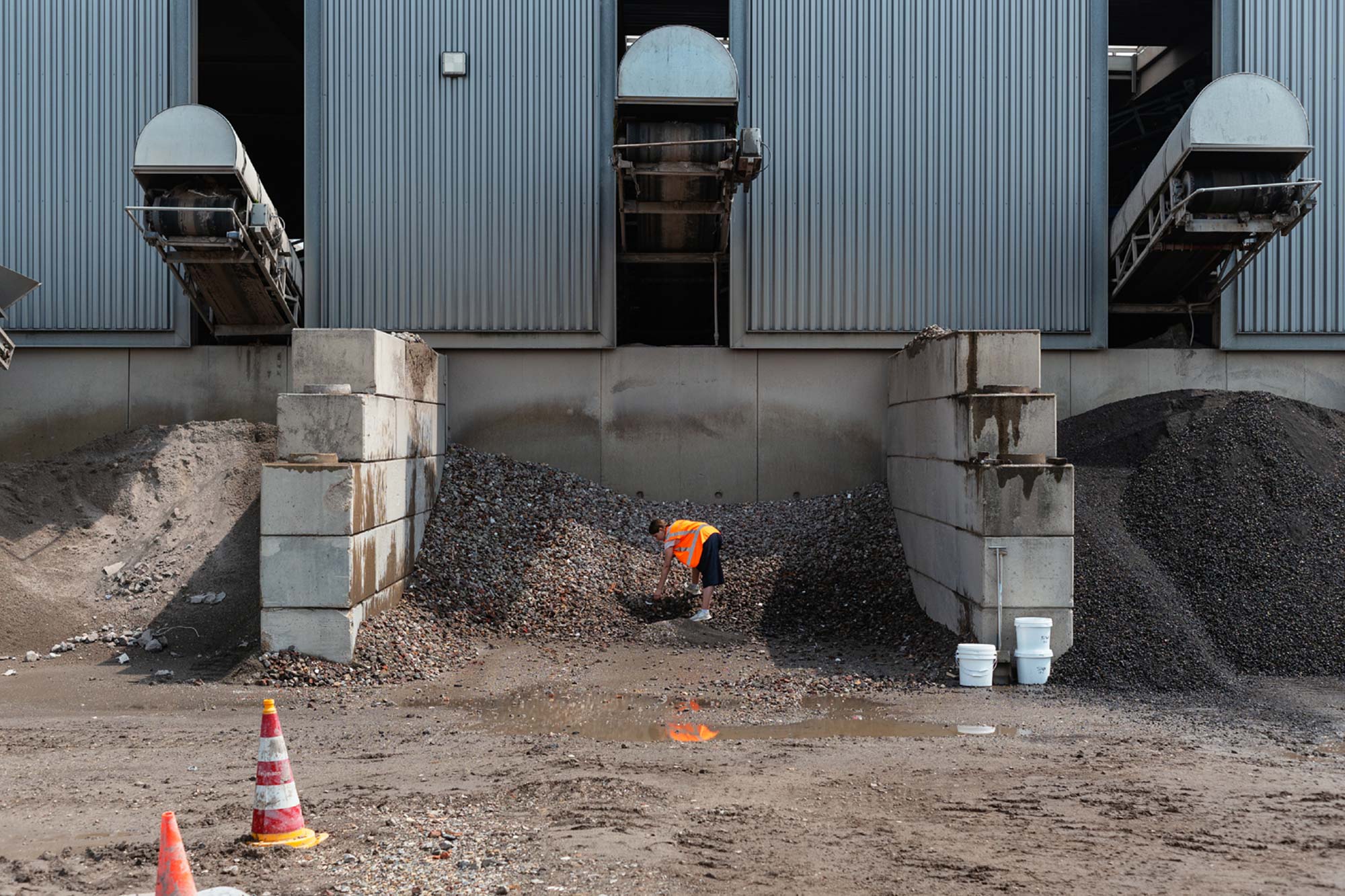
KLUTZ is part of the object family Soft Rubble, a series of spatial constructs in which building rubble and textile find spatial expression sometimes as a wall segment, sometimes as urban furniture. In the project Soft Rubble, which Charly Blödel started during her master studies at the Design Academy Eindhoven (2020), she focuses on the social and ecological implications of spatial design and production systems with a special focus on waste and material culture in the context of the climate crisis.
For more information on KLUTZ at Architekturwoche Basel 2022 and the programme from 09–15 May, 2022, please visit architekturwochebasel.ch
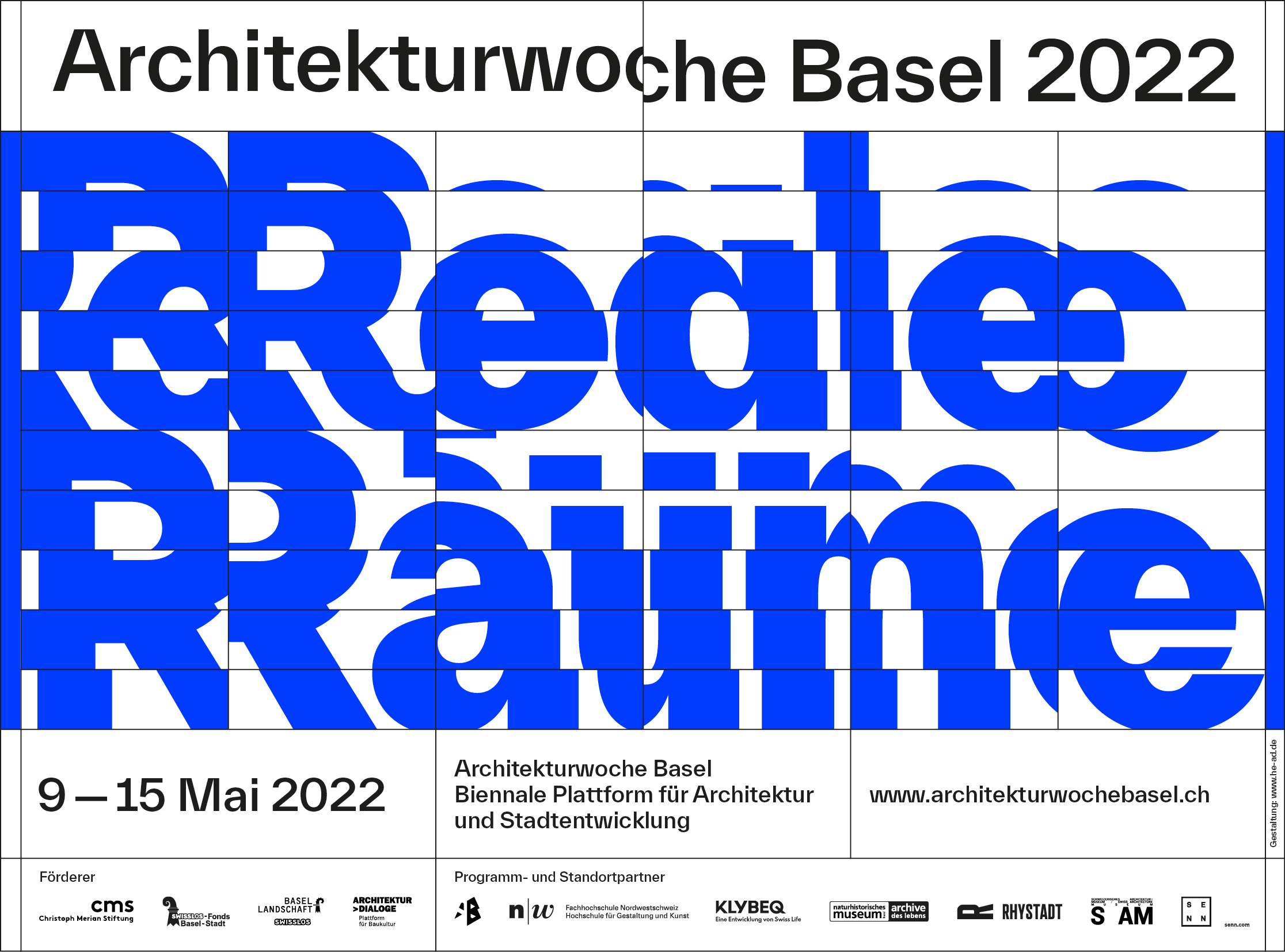
© Charly Blödel, 2022. For more Imprint.
KLUTZ @ Architekturwoche Basel 2022
At around 74 million tons per year, construction waste is the largest waste stream in Switzerland. As mixed construction waste, concrete, brick, tile and asphalt are not used to construct new buildings, but are used as secondary materials to fill depleted quarries and other landscape and infrastructure work. Thus, a material that was originally mined from the natural landscape as a valuable raw material flows back into a man-made landscape as a worthless waste material. How can worthless waste become a valuable resource? This is the question posed by KLUTZ, an urban furniture made of textile and building rubble.
KLUTZ is on show for the first time as part of the Basel Pavillon at Dreispitz, during Architekturwoche Basel from 09–15 May, 2022.
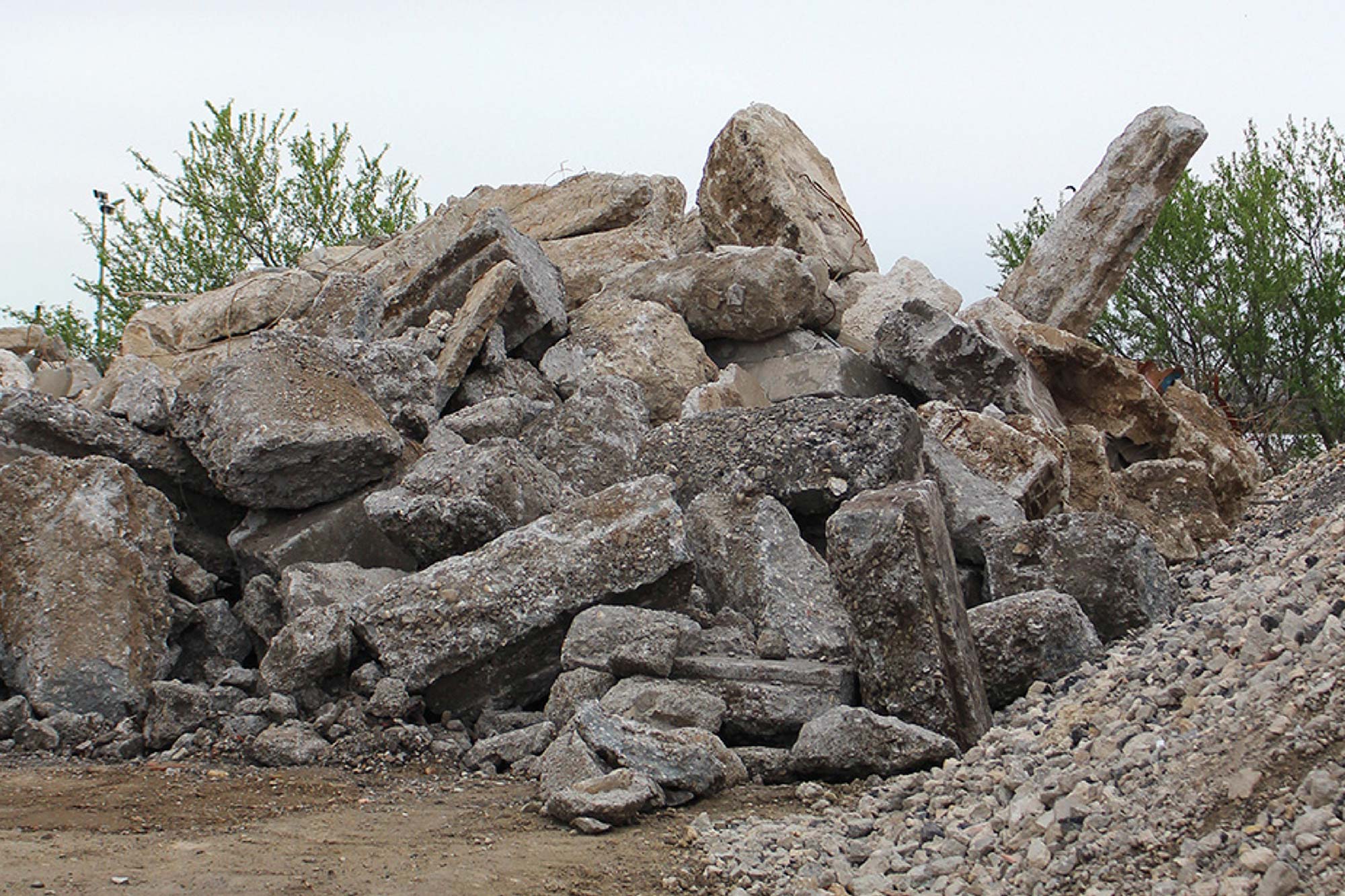
KLUTZ is an urban seating furniture made of textile. But it is only by filling it with construction waste that KLUTZ becomes a seat. As a bag module, KLUTZ is easy to transport, empty and refill. This is how KLUTZ travels through different urban contexts. “What’s in the bag?” is a recurring question. In a variety of spatial configurations and mixtures of filling materials, KLUTZ becomes a performative tool to engage with the interplay of value and valuelessness in urban space.

KLUTZ is built by hand in a performative build-up the start of the architecture week.

As a cluster of bag-modules, KLUTZ will provide the context for panel discussions, interviews and lectures at the Basel Pavillon, the main location of the Architekturewoche Basel 2022.

As a bag-module, KLUTZ will provide the context for panel discussions, interviews and lectures at the Basel Pavillon, the main location of the Architekturewoche Basel 2022.
KLUTZ is part of the object family Soft Rubble, a series of spatial constructs in which building rubble and textile take the spatial form of wall segment or urban furnitures contextual to their immediate surroundings and material supply. In the project Soft Rubble, which Charly Blödel started during her master studies at the Design Academy Eindhoven (2020), she focuses on the social and ecological implications of spatial design and production systems with a special focus on waste and material culture in the context of the climate crisis.
KLUTZ will be on show for the first time at the Architekturwoche Basel 2022 from 09–15 May, 2022 as part of the Basel Pavillon, the main location of the event, hosting panel discussions, interviews and lectures during AWB 2022 and throughout the summer programme of 2022.
For more information on KLUTZ at Architekturwoche Basel 2022 and the programme from 09–15 May, 2022, please visit architekturwochebasel.ch
KLUTZ will be introduced at the (ZOOM) LECTURE: KLUTZ — What’s in the bag? (in German) on 21 April, 2022 at FHNW Basel. Sign up here.
The guided tour around KLUTZ (in German & English) during AWB 2022 will take place on Tuesday, 10 May, 2022 at 14:00–15:00 and 16:00–17:00. Sign up for the tour here.


Basel is recognized as Switzerland’s architectural capital. Hardly any other region is home to so many internationally active architectural offices. In order to showcase the highly diverse potential of building culture, expertise and enthusiasm in the city and surrounding area, Architektur Dialoge has initiated a new biennial platform for architecture and urban development: the Architekturwoche Basel (AWB). The first edition will be held from 9–15 May 2022.

Soft Rubble, wall segment with window and seat, built by Team KLUTZ (2020). Photo: Viktor Hübner
© Charly Blödel, 2022. For more Imprint.
Seedless Fruit
We have tamed nature into our fields, domesticated it into our gardens, let it enter the urban landscape and the interior of our city homes. Now, how, — as we leave the permanent home, merge into a state of flux between temporary spaces of living, working, connecting — how do we render nature into the picture? Will it accompany us outside again to offer itself to us as we walk the street, pass through the metro station, catch the bus and pick, plug, harvest and enjoy the fruit of tomorrow?
Seedless Fruit is a series of artefacts containing shape studies in plaster merging existing fruit and vegetable types, documentation of harvesting postures and a 5-course meal to be harvested from designated food objects, and Seedless Fruit, the next generation of fruit designed on the basis of natural growth patterns and consumer data.
Seedless Fruit is a year-long design research project as part of the 100 Product for 2050 project with the tutors Eric Klarenbeek and Maartje Dros at DAE.

Analysis of natural growth and rotting processes of common fruit and vegetables

3D-printed Seedless Fruit, the next generation of fruit designed on the basis of natural growth patterns and consumer data

3D-printed Seedless Fruit, the next generation of fruit designed on the basis of natural growth patterns and consumer data

The Publication Seedless Fruit showing »Sea Salt Pastry layered with ceramic slabs« as part of the Food/Material Series that incorporates the picking and plugging moments of harvesting into a 5-course meal

Movements and body postures in the harvesting of different fruit and vegetable types

Shape studies in plaster merging existing, naturally grown fruit and vegetable typologies. (Photography by Niclas Ekwall)

Publication Seedless Fruit including a series of interviews with several local Dutch chefs on the topic of synthetic optimisation of food crops
»The melong is a fruit grown in 5 hours and 35 min- utes. Beginning from 1 to 2 a.m. in different time zones slightly varying due to their urban context, movement can be noticed on the drop-like nozzle tip of the stem. Descending from the ceiling of the tram stop, the manufacturing plant produces a soft-tex- tured blob. It fills with a juicy, fibred liquid, thicken- ing as it runs down the soft interior of the fruit.«
Excerpt from the publication Seedless Fruit

3D-printed Seedless Fruit, the next generation of fruit designed on the basis of natural growth patterns and consumer data

3D-printed Seedless Fruit, the next generation of fruit designed on the basis of natural growth patterns and consumer data

Publication Seedless Fruit giving an insight into the development towards the next generation of fruit tailored to meet improved efficiency and consumer data

The Publication Seedless Fruit showing »Baiser creme elevated on metal cloud« as part of the Food/Material Series that incorporates the picking and plugging moments of harvesting into a 5-course meal

The Desert »Dark Chocolate Splits Coating Flexible Acrylic Tubes« as part of the Food/Material Series that incorporates the picking and plugging moments of harvesting into a 5-course meal
© Charly Blödel, 2022. For more Imprint.
Rubble Probes—
Soft Rubble as a Building Process
The publication Rubble Probes explores Soft Rubble applied as a the construction system in the temporary contexts of the urban space in transformation. In form of spatial structures based on historical vernacular typologies, Soft Rubble becomes a tool for appropriation and activation as it inserts itself into the abandoned land plots or disused gaps found across Rotterdam. Assembled by the local neighbourhood by use of local building rubble, Rubble Probes become means to appropriate the temporary square adjacent to on-going construction sites, unused public spaces or as part of temporary cultural programming.
Rubble Probes is a collection of Rotterdam-based narratives of possible application of the textile construction system Soft Rubble. Soft Rubble is a master thesis project developed by Charly Blödel in the Social Design Department at the Design Academy Eindhoven in 2020.

»The Shelter«, based on the jardinu pantescu, the typical enclosed dry-wall gardens for single trees in Sicily




»The Cooler«, based on the yakhchal, the ancient ice pit developed by the Persions 400 BC to store ice in the desert




»The Pod«, based on the Sassi di Matera, the cave dwellings still inhabited today in the Southern Italian city of Matera



»The Windbreaker«, based on the cabane de camargue, rounded, reet-thatched houses positioned in direction to withstand the strong Mistral winds in the Camargue region of France
© Charly Blödel, 2022. For more Imprint.
Urban Quarries & Material Imaginaries,
An On-going Research Residency at
Atelier Luma, Arles [FR]
Production Processes of Construction Waste in Arles documents the preliminary research and mapping of building rubble in and around Arles. Construction waste is a material flow that occurs on diverse sites and in various mixtures. It is a material flow that is split up between these sites of production and entangled in the different frameworks of economic interest and policy.
This collection of processes gives an insight into the sites, circumstances and parties involved in the production of such mono-material and mixed-matter conglomerates. It provides a basis on which to question the conditions under which these conglomerates are produced and the systems that hold in place the concept of ‘waste’.

Terre Durable in Nîmes, a recycling facility, depo and supplier for crushed building waste



Hills of building waste integrating into the landscape

Part of the preliminary research was the mapping of building waste retrieved from one of the buildings part of the Luma Foundation that is currently under renovation.

The catalogue of quantified materials that are extracted during the renovation allows for the reemployment in custom-made materials for the new building.

Building rubble is a site-specific material that illustrates a local mixture of minerals. Due to Arles rich heritage as part of the Roman Empire, the local rubble contains a remarkable amounts of marble.

“Arles is the result of these early recycling patterns due to the nat- ural resource shortage inherent to Arles’s geographical location. It is a patchwork that has turned invisible on St. Trophine but certainly still recurs in the fragments of construc- tion waste that scarcely leave the historical centre yet present them- selves in pieces of marble among the common crushed concrete, clay tile and gravel on waste recycling sites such as the one of Terre Durable before they are filled back into the ground in road construction works or landscaping works.”
Excerpt from the essay ‘A Local Mixture’ in the publication

© Charly Blödel, 2022. For more Imprint.
Soft Rubble
Building rubble – one of the world’s largest waste streams – is mainly downcycled for the construction of roads, the backfilling of exhausted quarries and other landscaping processes. As the seemingly valueless material is filled back into the ground, the natural landscape we quarry to create it turns into a man-made landscape that stays untouched.
With Soft Rubble, Charly Blödel investigates mechanisms of value production and loss. In a performative build-up, textile containers made of Polyethylene sheet are filled manually with crushed rubble. This construction system can be filled and emptied repeatedly to create a variety of spatial configurations, becoming a tool to engage with the changing value of our material surroundings.
- PhotographyViktor Hübner
- ProductionZeilmakerij Van Doorn, Rotterdam
- Material Supply & Building SiteVan Berkel Bouwstoffen & Transport

The Western city exists in a state of hyper-productivity resulting in an imminent reproduction of the urban built environment. As a new building is erected, the previous is rendered obsolete. This swift exchange generates swaths of building waste. In 2015 alone, the city of Rotterdam produced 394.000 tons of building rubble. After being transported to a recycling facility this mixed-mineral waste is crushed and downcycled to filler material in landscaping and backfilling processes. Soft Rubble investigates mechanisms of both production and loss of value in the context of the fragile existence of raw matter on the verge of becoming mineral waste. It does so in the form of a construction process that positions building waste as building material.

To build the first prototype of Soft Rubble, 5 people filled 12 tons of building rubble into 4 bags in 8 hours.

The building team including Lisa Machemer, Charlélie Flamant, Matilde Losi, Daniel Parnitzke and Charly Blödel built the first prototype at Van Berkel Bouwstoffen & Transport, a building rubble recycling facility in Eindhoven on June 13th, 2020.

Soft Rubble is a tarpaulin construction system comprised of differently shaped textile containers made of 250g Polyethylene sheet. In a manual process, these reusable textile elements are filled with crushed building rubble to form rigid yet flexible stone walls. Any number of these containers can be combined and filled to create a variety of spatial configurations site-specific to local context and materiality. Preserving the porous material state of building rubble, Soft Rubble becomes a tool of activation to engage in both a physical and abstract manner with the changing value of our material surroundings.


The three-metre tall bags were produced by hand at Zeilmakerij Van Doorn in the Rotterdam Harbour.

Soft Rubble bags are made out of 250g Polyethylene sheet with nylon seams, reinforced with a polyester strap.
»While construction industries extract natural resources from the existing natural landscape in a process of gradual depletion, man-made material conglomerates are simultaneously reverted to the same landscape. As they are filled back into the ground, the natural landscape we quarry turns into a man-made landscape that stays untouched. Why do we quarry one landscape, while we stay blind to the other?«
Soft Rubble is a master thesis project developed in the Social Design Department at the Design Academy Eindhoven in 2020 with the support of the mentors Brecht Duijf , Stéphane Barbier Bouvet, Nadine Botha and Henriëtte Waal under the former head of department Jan Boelen.

On Quarrying A Man-Made Landscape is the written master thesis that accompanies the thesis project Soft Rubble.
© Charly Blödel, 2022. For more Imprint.
On Quarrying A Man-Made Landscape
The Western city exists in a state of hyper-productivity resulting in an imminent reproduction of the urban built environment. As a new building is erected, the previous is rendered obsolete. This swift exchange generates swaths of building waste. In 2015 alone, the city of Rotterdam produced 394.000 tons of building rubble. After being transported to a recycling facility this mixed-mineral waste is crushed and downcycled to filler material in landscaping and backfilling processes. On Quarrying A Man-Made Landscape investigates mechanisms of both production and loss of value in the context of the fragile existence of raw matter on the verge of becoming mineral waste. It does so in the form of a construction process that positions building waste as building material.
On Quarrying A Man-Made Landscape is a master thesis written by Charly Blödel in the Social Design Department at the Design Academy Eindhoven in 2020.

On Quarrying A Man-Made Landscape is the written master thesis that accompanies the thesis project Soft Rubble.
Abstract
The Western city portrays a state of hyper-productivity resulting in an imminent reproduction of the built environment that it inhabits. As a new building is erected, the previous is rendered obsolete. The swift exchange from use to disuse produces swaths of building debris that is being crushed and returned to the ground as a base layer in road construction or filler material for exhausted quarries and other landscaping purposes. While construction industries extract natural resources from the existing natural landscape in a process of gradual depletion, man-made material conglomerates are simultaneously reverted to the same landscape. As they are filled back into the ground, the natural landscape we quarry turns into a man-made landscape that stays untouched. What makes us avoid this other, man-made landscape is the mere ‘stuff’ that it is made of – waste.
How can we see this man-made landscape as a quarry and its material wealth as potential rather than waste? Tracing the condition under which raw matter can only become waste when framed as an industrial building material, waste is laid out as a social contract. Looking at the methodology of the three architectural practices of Rotor, BC Architects and Assemble, nostalgia is the strategy through which value is returned. Through the lens of the aforementioned practices, quarrying is outlined as a process of retrieval of raw matter, followed by the production of knowledge and affiliation with the local community, and eventually, its repeated usage becoming ritual. As such, the concept of quarrying reads as a local practice of creating value around the quarried matter rather than the industrial extraction of value as a pre-defined commodity.
Nonetheless, when nostalgia is utilised in the ‘re’-cycling, ‘re’-purposing, or ‘re’-use of waste, it is ultimately limited to a form of repair. Therefore, I argue that an alternative perception is required, a perspective that loses the ‘re’ and deviates from moving backwards towards the next level of progress. In this context, the concept of the quarry is evolved as a narrative practice that changes the perception of waste into the perception of a raw man-made matter as it produces new stories for a changing landscape. This potential is discussed in the context of my own work Soft Rubble that uses textile as a temporary binder to configure construction rubble to a free-standing, load-bearing textile wall.
© Charly Blödel, 2022. For more Imprint.
